#1974 savage tales 5
Text
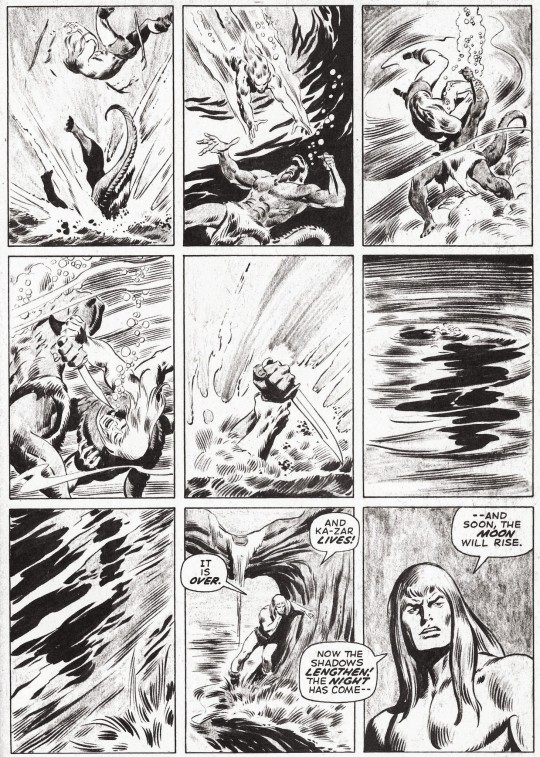
#make me a sandwich#1974 savage tales 5#ka-zar#70s#john buscema#art#retro#mcu#stan lee#words#comics#1970s#marvel comics#conan#culture#comic books#philosophy#life#marvel#existentialism#🔥
16 notes
·
View notes
Text

Savage Tales #5 July 1974
18 notes
·
View notes
Text
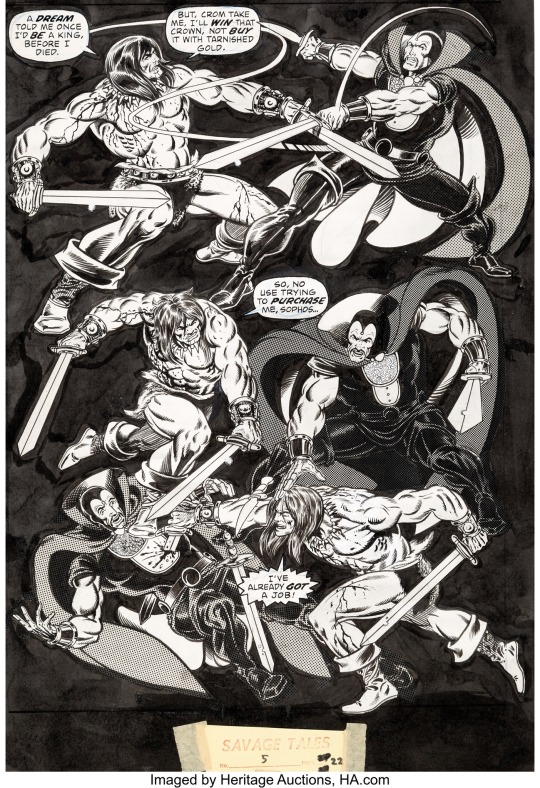
Jim Starlin and Al Milgrom - Savage Tales #5 Splash Page 18 Original Art (Marvel, 1974) Source
8 notes
·
View notes
Photo

Savage Tales #5
July 1974
Conan stars in "The Secret of Skull River" Reprints: Brak the Barbarian stars in "Spell of the Dragon" from Chamber of Chills 2 and Ka-Zar stars in "The Legend of the Lizard Men" from Astonishing Tales 9
2 notes
·
View notes
Text
Leading 10 Flick Muscular Tissue Cars And Trucks
I made a decision to choose the most effective movie muscle cars that have ever appeared on screens. The goal was to select just muscle automobiles and only from movies so a few major prospects didn't appear on this checklist due to the fact that they were from television series, was not a muscle cars and truck, or simply really did not enter into this listing. Anyhow, I wish to point out 1970-1971 Plymouth Barracuda from "Nash Bridge" [with Don Johnson], Cobra from "Cobra" [with Michael Dudikoff], non muscle mass but unique and iconic 1981 DeLorean DMC-12 from "Back to the Future", 1977 Pontiac Trans Am from "Smokey as well as the Outlaw", 1958 Plymouth Fury from "Christine", "Kitt" - Pontiac Firebird Trans Am from "Knight Rider", 1969 Dodge "01 ″ Battery charger from "The Dukes of Hazzard",1959 Cadillac Rescue from "GhostBusters", and so on. Each of them is a person's dream cars and truck, each is ideal in some ways, however here's our TOP 10 Film Muscle Mass Autos:
1. Bullitt - 1968 Ford Mustang GT 390 from "Bullitt", 1968
1968-ford-mustang-bullitt-steve-mcQueen-poster - Most likely this is the only unmodified motion picture Mustang ever. It has substantial 325 HP, an actual American muscle car's heart under the hood - the hostile 6.4 liter V8 engine, 4-speed guidebook transmission [which absolutely looks difficult to move] and sporty back wheel drive to enjoy while cornering. What else do you need from a real muscle mass automobile for chases after, especially back in 1968?
2. 1970 Dodge Challenger R/T 440 from "Vanishing Point", 1971
1970-dodge-challenger-rt-vanishing-point - This set was a hot design with shocking 375 HP, 440 cubic [7.2 liter] V8 which plays probably the sweetest automative soundtrack. Would You handle to discover a far better car for Kowalski to drive from Denver to San Francisco in 15 hrs?
3. Eleanor - 1967 Ford Mustang Shelby GT500 from "Gone in 60 seconds", 2000
Mike Savage New Canaan
eleanor-mustang-1967 - Eleanor is possibly the most replicated muscular tissue flick vehicle ever to show up in screens. Although the initial movie from 1974 was a hit, the 2000 took the show for certain. There were 11 Eleanor systems constructed for this flick as well as just 3 of them were real running as well as driving automobiles. In the motion picture it served as Shelby, but actually they were customized Mustang fastbacks. The movie transmission was a 4-speed handbook, however the stunt cars were automated for less complicated act. Genuine tale.
4. The Interceptor - Australian 1973 Ford Falcon XB GT Coupe from "Mad Max", 1979
ford-falcon-interceptor-back-mad-max - This was one of the most modified automobile in that film. XB GT Falcon was developed specifically for Australian market as well as there were only 949 devices built. It featured 351 Cleveland engine as well as 4-speed guidebook transmission The motion picture auto maintained most of the original interior, but body had some significant modifications: brand-new nose layout, back looters, Weiand 6-71 supercharger with Scott injector had, 4-barrel carburetor and also the Zoomies - side pipes. Australians boast of this car and also make reproductions of it.
5. Bumblebee - Chevrolet Camaro from "Transformers", 2007
Transformers Autobot Towers Over Chicago Vehicle Program Crowd - The Transformer's Bumblebee made Camaro one of the most popular auto of the year. Well, not just it changes and looks excellent, however has a modern-day amcar engine - 6.2 liter V8 which ranks 426 HP and also does 0-60 in 4.8 seconds ...
6. 1968 Dodge Battery Charger R/T 440 Magnum from "Bullitt", 1968
Dodge-charger-from-bullitt - This triple-black, 4-speed Charger went after the Mustang in the "Bullitt" film and made one of the best automobile chase scenes ever before shot. When the jumping act was performed over the San Francisco hillsides the Charger never fell short with the suspension. Would you be able to call an automobile from nowadays that could do that without ending as scrap?
7. Cobretti's personalized 1950 Mercury Monterey from "Cobra", 1986
mercury-monterey-from-cobra-2 - Cobretti's [Sylvester Stallone] 1950 Mercury is possibly the most crucial thing in the whole film. It was previously had by Stallone himself and also later on built for the film by Cinema Automobile Providers. They double-scooped the hood, cleansed all extra trim, fitted 383 Chevrolet small block, topped it with nitrous-aided 4-barrel Holley carburetor which additionally had Weiand 144 supercharger. The transmission was a 400 Turbo Hydraulic with 4-wheel brakes. A good automobile to disclose Cobretti's character as well as join this Leading 10 listing.
8. 1966 Shelby 427 Cobra from "The Gumball Rally", 1976
Shelby-cobra-427-gumball-front-2 - The movie itself was inspired by a cross nation driver Erwin G. "Cannonball" Baker who took care of to drive throughout the country from coastline to shore in concerning 54 hrs. This funny had several interesting vehicles on act, such as Ferrari Daytona, Porsche 911, 600 HP Camaro, Jaguar E-type, Exchangeable Corvette, Mercedes Roadster as well as even a Kawasaki motorbike. There were only 2 different, but original Shelby Cobra autos in this flick [CSX 3243 as well as CSX 3255] These 427 cubic [7 liter] OHV muscle mass automobiles took care of to inflate to 355 HP. This was actually excellent trip across the country with legendary muscular tissue cars and trucks ...
Mike Savage New Canaan
9. Bond's 1964 Aston Martin DB5 from "Goldfinger", 1964
aston-martin-db5-james-bond-movie - The DB5 is renowned for being the initial and most recognised film auto in James Bond films. DB5 had 4 liter [282 HP], 5-speed transmission. Originally, Ian Fleming [the unique writer] had positioned DB Mark III, but DB5 was the latest Aston at that time. In fact, they made use of the prototype cars and truck and also fitted it with lots of weaponry that fat stripped after the film and also resold. The same car showed up in a few other Bond's movies also. If You would certainly ask somebody to say "what Bond's vehicle is", the one would most definitely name Aston Martin. Good auto completely agent.
10. 1957 Ford Fairlane 500 from "Rumbling Roadway", 1958
1957-ford-fairline-500-thunder-road - The movie personality actually drove 2 automobiles there - 195 Ford Coupe as well as 1957 Ford Fairline 500 which was the top of the Ford line. The 312 cubic V8 engine created 245 HP and had automatic transmission. Good selection for 1950s if You actually need "to take somebody out".
0 notes
Photo

TV Guide - April 28 - May 4, 1962
Ronald Robert Harper (born January 12, 1936) Television and movie actor.
His first television role was in 1960 for the NBC television series Tales of Wells Fargo. Steady television guest appearances followed, including a role on NBC's series The Tall Man. In December 1960, he appeared in the episode "Duel at Parkison Town" of NBC's Laramie.
Harper appeared in soap operas, including CBS's series Where the Heart Is and Love of Life. He appeared as a regular performer for several television series, including Planet of the Apes, and as Uncle Jack for the third season of Land of the Lost. His movie credits included roles in Below Utopia (1997), The Odd Couple II (1998), Freedom Strike (1998), Glass Trap (2005) and The Poughkeepsie Tapes (2007).
Other TV appearances were 87th Precinct (1961–1962), Wendy and Me (1964–1965), The Jean Arthur Show (1966), Garrison's Gorillas (1967–1968), Planet of the Apes (1974), Land of the Lost (1976), Loving, Capitol and Generations. (Wikipedia)
--------------------------------------------------------------
Robert Lansing (/ˈlænsɪŋ/; born Robert Howell Brown, June 5, 1928 – October 23, 1994) Stage, film, and television actor.
Lansing is probably best remembered as the authoritarian Brig. Gen. Frank Savage in 12 O'Clock High (1964), the television drama series about American bomber pilots during World War II. During his long career, which spanned five decades, Lansing appeared in 245 episodes of 73 television series, 11 TV movies, and 19 motion pictures.
Lansing first appeared on TV on Kraft Television Theatre in 1956. In the 1961–1962 television season, Lansing was cast as Detective Steve Carella on NBC's 87th Precinct series, based on the Ed McBain detective novels. His costars were Gena Rowlands, Ron Harper, Gregory Walcott, and Norman Fell. Also in 1961, he played Jed Trask, a troubled shooter, in the Bonanza episode, "Cutthroat Junction". He guest starred in two other episodes of the NBC's western series: "Danger Road" (1970) as Gunny O'Riley and "Heritage of Anger" (1972) as John Dundee. He played Doc Holliday in an episode of NBC's The Tall Man, with Barry Sullivan and Clu Gulager. Lansing would star alongside Clu Gulager again in a 1965 episode of NBC's The Virginian TV series titled "The Brothers". Again on NBC, in 1966, Lansing guest-starred as General Custer in a three episode segment of Branded called "Call to Glory".
Other television roles include portrayals of an alcoholic college professor in ABC's drama Channing, as Gil Green in the 1963 episode "Fear Begins at Forty" on the NBC medical drama The Eleventh Hour, as a bounty hunter on Gunsmoke, and as a parole officer in a 1968 episode ("A Time to Love — A Time to Cry") of The Mod Squad.
He was the interstellar secret agent Gary Seven in a Star Trek episode ("Assignment: Earth", 1968), which also featured Teri Garr, and was originally intended as a backdoor pilot for an unsold new series.
Lansing played an international secret agent in The Man Who Never Was, and Lt. Jack Curtis on Automan. He also played a recurring role, known only as "Control", on 29 episodes of The Equalizer between 1985 and 1989, which then was spun-off into the made-for-TV movie Memories of Manon which aired on 13 February 1989. He guest-starred in The Twilight Zone episode "The Long Morrow" and in the Thriller episode "Fatal Impulse." He also guest-starred on other television productions such as NBC's Law & Order.
Lansing's final television role was that of Police Captain Paul Blaisdell, on the series Kung Fu: The Legend Continues. (Wikipedia)
#TV Guide#TV#1962#Ron Harper#Robert Lansing#87th precinct#Twelve O'Clock High#The Equalizer#Kung Fu: The Legend Continues#The Man Who Never Was#Where the Heart Is#Love of Life#Planet of the Apes#Wendy and Me#Garrison's Gorillas#Land of the Lost#Capitol#Generations
17 notes
·
View notes
Text

Young biochemist Dr. Theodore "Ted" Sallis, a native of Omaha, Nebraska,[28] is working in the Everglades as part of Dr. Wilma Calvin's Project: Gladiator team, which includes Dr. Barbara Morse and her fiancé Dr. Paul Allen, and an assistant named Jim. A Dr. Wendell is later cited as being on the staff after Dr. Calvin is shot.[29] The group is attempting to recreate the Super-Soldier Serum that had created Captain America.[30] Web of Spider-Man (vol. 2) #6 revealed that Sallis at one point treated and worked alongside Dr. Curtis Connors shortly after Connors' arm was amputated, driving the research that would eventually transform Connors into the Lizard.
Though warned that the technological terrorist group Advanced Idea Mechanics (A.I.M.) has been operating in the area, Sallis breaches security by bringing with him his lover, Ellen Brandt (referred to here as "Miss Brandt", but later retconned to be his wife). He destroys his notes to his formula, which he has memorized. Later, he is ambushed by two thugs and learns that Brandt has betrayed him. Fleeing with the only sample of his serum, he injects himself with it in hopes of saving himself. However, he crashes his car into the swamp where scientific and, as Man-Thing #1 later explained, magical forces combine to instantly transform him into a slow-moving plant-matter creature with large, solid red eyes.[31] Unable to speak, and with dim memories, he attacks the ambushers and Brandt, burning and scarring part of her face with an acid that he now secretes in the presence of negative emotions. The Man-Thing then wanders away into the swamp.[32]
Sallis' mind was apparently extinguished, although on rare occasions he could briefly return to consciousness within his monstrous form, as in Doctor Strange (vol. 2) #41 (June 1980), The Defenders (vol 1) #98 (August 1981), and Peter Parker: Spider-Man Annual '99, and even to his human form, as in Adventure into Fear #13 (April 1973), Marvel Two-in-One #1 (January 1974), Marvel Comics Presents #164 (October 1994), and Man-Thing (vol. 3) #5 and 7-8 (April 1998, June–July 1998).
Under writer Steve Gerber, the Man-Thing encounters the sorceress Jennifer Kale, with whom he briefly shared a psychic link and who knew his true identity, in a story arc in Fear #11-13 – the final issue of which established that the swamp had mystical properties as the Nexus of Realities. Through an interdimensional portal in Fear #19, he meets Howard the Duck, who becomes stranded in this reality. The Man-Thing became the guardian of the Nexus, and found himself facing demons, ghosts and time-traveling warriors, while continuing to encounter such non-supernatural antagonists as rapacious land developers, fascist vigilantes and common criminals. He formed a bond with young radio DJ Richard Rory and nurse Ruth Hart. Issue #12's "Song-Cry of the Living Dead Man", about an crazed writer named Brian Lazarus, spawned Gerber's posthumously published 2012 sequel, "The Screenplay of the Living Dead Man", in the three-issue miniseries The Infernal Man-Thing.
In Man-Thing (vol. 2) #1-11 (November 1979 – July 1981), writer Chris Claremont introduced himself as a character in the final issue, as Gerber had in the finale of the first series. Additionally, Claremont temporarily became the Man-Thing after being stabbed to death. His and other characters' deaths were later resolved with the intervention of the War Is Hell series lead, John Kowalski, now an aspect of Marvel Comics' manifestation of Death. In Man-Thing (vol. 3) #1-8 (December 1997 – July 1998), Ellen Brandt Sallis returns to the Citrusville area and encounters a little boy, Job Burke, who is actually the Sallises' son, who had been put up for adoption. Following this series, the story continued in Strange Tales (vol. 4) #1-2, and was projected to continue in the unpublished issues #3-4. Summaries based on DeMatteis' unillustrated scripts appear on the K'Ad-mon and Ellen Brandt pages in Appendix to the Handbook of the Marvel Universe.[21][22]
During the "Civil War" storyline, two S.H.I.E.L.D. agents unsuccessfully attempt to register the Man-Thing under the Superhuman Registration Act.[33]
The Man-Thing later appears as a member of the Legion of Monsters alongside Morbius, the Living Vampire, the Werewolf by Night, the Manphibian, and N'Kantu, the Living Mummy.[34] He later gains the ability to speak comprehensibly through the use of the "Universal Language".[35] Phil Coulson subsequently recruits the Man-Thing for his incarnation of the Howling Commandos.[36]
As part of the All-New, All-Different Marvel branding, the Man-Thing appears as a member of S.T.A.K.E.'s Howling Commandos.[37]
During the "Empyre" storyline, Man-Thing falls under the control of the Cotati led by Ventri that were operating in the Savage Land.[38] Doctor Voodoo takes control of Man-Thing to free Matthew and Black Knight. As Matthew and Black Knight fight the Cotati, a Doctor Voodoo-controlled Man-Thing fights the Cotati's control and defeats Ventri.[39] As Doctor Voodoo exits Man-Thing to assist Scarlet Witch after Ka-Zar was stabbed by a Cotati using Black Knight's Ebony Blade, Man-Thing continued the fight against the Cotati. When the Cotati were defeated, Man-Thing takes his leave after being thanked by Black Knight. Ventri claims that what they learned from Man-Thing's energy has been sent to Quoi to fuel the Cotati's invasion.|[
4 notes
·
View notes
Photo

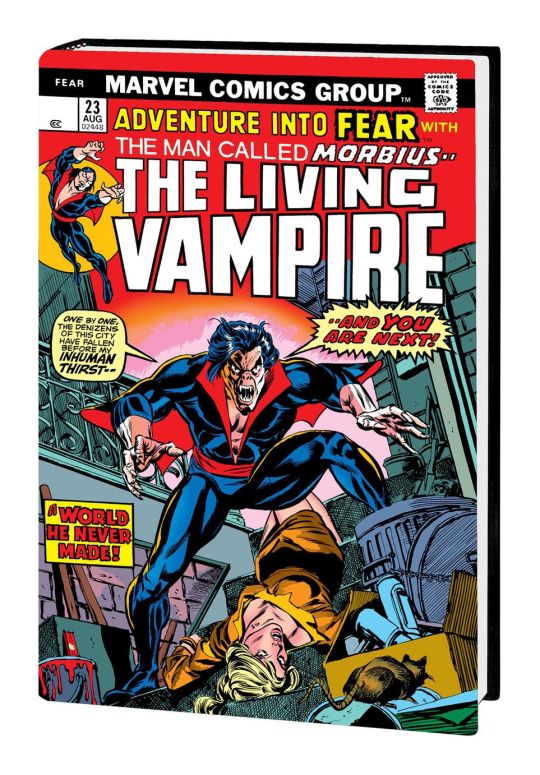
MORBIUS THE LIVING VAMPIRE OMNIBUS HC HOTZ COVER
Written by STEVE GERBER, DON McGREGOR & DOUG MOENCH with ROY THOMAS, GERRY CONWAY. MIKE FRIEDRICH, BILL MANTLO, ARCHIE GOODWIN & DAVID ANTHONY KRAFT
Penciled by GIL KANE, P. CRAIG RUSSELL, FRANK ROBBINS & RICH BUCKLER with ROSS ANDRU. PAUL GULACY, DON HECK, PABLO MARCOS, GEORGE EVANS, VIRGILIO REDONDO, TOM SUTTON. MIKE VOSBURG, SONNY TRINIDAD, ARVELL JONES & SAL BUSCEMA
Covers by KYLE HOTZ & GIL KANE
Cursed by an experiment gone wrong, Dr. Michael Morbius is possessed by an unquenchable thirst for blood — yet his heart beats like any other man. He is a living vampire! And in this amazing Omnibus, the complete original Morbius saga is collected — from his first appearance through both his first color comic and black-and-white series and into the rare stories that concluded his tragic tale. The sometimes mad, sometimes misunderstood Morbius contends not just with Marvel’s heroes but also with bizarre cultists and satanic demons! Journey to the darker side of Marvel, a world of horror and the supernatural that overtook the industry in the 1970s and defined comics for a generation. Collecting AMAZING SPIDER-MAN (1963) #101-102; MARVEL TEAM-UP (1972) #3-4; FEAR #20-31; GIANT-SIZE SUPER-HEROES #1; MARVEL PREMIERE #28; MARVEL TWO-IN-ONE (1974) #15; PETER PARKER, THE SPECTACULAR SPIDER-MAN (1976) #6-8 and #38; SAVAGE SHE-HULK #9-12; and material from GIANT-SIZE WEREWOLF #4; VAMPIRE TALES #1-5, #7-8 and #10-11; and MARVEL PREVIEW #8.
864 PGS./Rated T …$100.00
ISBN: 978-1-302-92240-5
Trim size: oversized
MORBIUS THE LIVING VAMPIRE OMNIBUS HC PEREZ COVER (DM ONLY)
864 PGS./Rated T …$100.00
ISBN: 978-1-302-92241-2
Trim size: oversized
1 note
·
View note
Text
Dracula vs. The Marvel Universe! 14 Times The Lord of The Undead Fought Superheroes!
https://ift.tt/31rfcKg
Hey, remember that time Dracula fought the Hulk? Or the X-Men? Or Spider-Man? No? Well, you're in luck, because we do!
facebook
twitter
tumblr
Dracula. The very name conjures images of sexuality, corruption, and decadence. From the original novel written by Bram Stoker in 1897 to the moment Bela Lugosi donned the famed opera cloak in 1931, the character of Dracula has been an iconic horror staple.
In fact, Dracula has been the subject of over 200 films, second only to the number of films starring Sherlock Holmes. But films, novels, and television aren't the only genres that have contained Dracula’s bloodlust. Comic books have been a compelling source for new Dracula material. Marvel Comics in particular have been a happy hunting ground for the Lord of the Vampires.
After the easing of Comic Code restrictions in the early seventies, Stan Lee and Marvel were eager to explore classic monsters in the pages of their books. When the code loosened its grip, Lee and company were able to resurrect the four color boogiemen that lay forgotten for so long. In 1972, writer Gerry Conway and artist Gene Colan introduced Tomb of Dracula and a legend was born. Now there was a version of Dracula that borrowed from Stoker and Lugosi stalking the same fictional universe as Spider-Man and the Avengers.
Soon, writer Marv Wolfman would take over the writing chores on Tomb of Dracula and create one of the greatest continuing horror sagas in comic book history. Within the pages of Tomb of Dracula, Wolfman introduced the vampiric detective Hannibal King, Lilith (Dracula’s Daughter), and most importantly, Blade, the Vampire Hunter, who later helped kick off the current superhero movie boom.
Amazon has all your Marvel Dracula needs
Dracula existed within the Marvel Universe, but other than rare occasions not many Marvel heroes appeared in Dracula’s book, giving the title a sense of isolation from the rest of the Marvel Universe. That is not to say that Dracula has not stalked the titles of the mainstream Marvel heroes. Oh no, dear reader, the Prince of Darkness has cast his shadow on many Marvel heroes, making him one of the greatest, if often overlooked villains in Marvel history. Here is a look at times Dracula, the greatest monster of them all, has stalked the Marvel Universe.
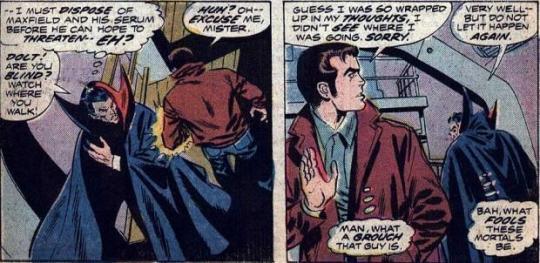
Dracula Meets Spider-Man
Giant Sized Spider-Man #1 (1974)
In this tale, Aunt May is suffering from a rare blood disease because she’s Aunt May. Spidey learns that the only man that has the cure is an eccentric doctor that refuses to travel by plane. Spider-Man learns from Reed Richards that the scientist is traveling by ship, so Spidey gets his webbed ass to the ship to find the doctor.
Also on board the ship are members of the Maggia who want the formula, and of course, Dracula himself who is also after it. Hilarity ensues as Dracula dispatches the crooks one by one, and throws the Maggia leader overboard.
read more: 13 Essential Horror Comics
The book is a send up of the classic death at sea sequence of Stoker’s Dracula, as Dracula feeds off the Maggia onboard. While never featuring a direct confrontation between hero and vampire, this issue served as a warning...Dracula is out there.
Buy it on Amazon
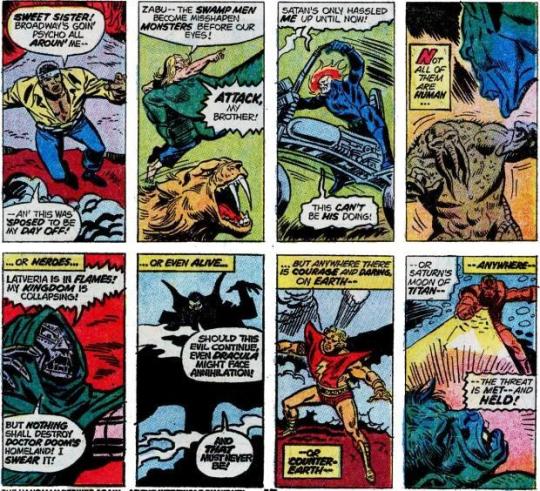
Allied with the Avengers (1973)
Avengers #118
Ironically, one of the first times Dracula was drawn into the events of the Marvel Universe, he did so to defend humanity! In the Avengers/Defenders war, often considered to be the first true crossover in comics history, the Dread Dormammu opened a dimensional gateway to Earth. The Avengers and Defenders were stuck in Dormammu’s dimension so could not defend the Earth from an incursion by the savage Mindless Ones, headless beings that thrive on destruction. A group of super-powered champions on Earth, not knowing where the Mindless Ones were pouring on from, took up arms to protect their home.
read more: The Weird History of Marvel Superheroes vs Monsters
One of these beings was none other than Dracula, who along with such heroes as Power Man, the Fantastic Four, and Ka-Zar, fought back against the Mindless Ones. But don’t think Dracula was acting magnanimously true believers; imagine if a horde of beasts was smashing your favorite eatery. That’s what Earth is to Dracula, a theme restaurant with an all you can eat buffet of jugulars.
Yes, Dracula fought the Mindless Ones, but in doing so he made sure his food supply remained strong and proved to Marvel readers just how badass he was by taking on the Mindless Ones...creatures capable of going toe to toe with the Hulk!

The Creation of Baron Blood (1976)
Invaders #7
One of Captain America’s most enduring foes was created by none other than Dracula. What’s more evil than a Nazi vampire? Pretty much nothing, which makes Baron Blood one of the most vile creatures in the Marvel Universe. In the dark days of World War II, John Farnsworth was an English aristocrat obsessed with vampire lore. When he travels to Transylvania, he encounters Dracula, who transforms Farnsworth into the living dead.
Dracula sends blood to England to punish the country for the actions of Dracula’s nemesis Jonathan Harker. As Baron Blood, Farnsworth fought the Invaders, Captain America, and even his own brother who adopted the heroic persona of the first Union Jack.
read more: The Best Modern Horror Movies
Blood’s days of fighting for the Axis were cut short when the Sub-Mariner staked the bejesus out of him. Blood was resurrected in the modern day by a minion of Dracula and fought a legendary battle with his old foe, Captain America. Now, a Nazi vampire is pretty badass, but a Nazi vampire created by Dracula himself? That’s some legendary bloodsucker right there!
Available in - Invaders Classic: The Complete Collection Vol. 1

Dracula vs. Doctor Strange (1976)
Tomb of Dracula #44
The Lord of Darkness fed off Doctor Strange (he probably tasted like sage, cinnamon, and quickly forgotten dreams), in the pages of Tomb of Dracula #44. In Strange’s own book, Dracula locks the Sorcerer Supreme in a dungeon so he can watch the embraced Doctor arise as a vampire. That’s quite a sense of irony Marvel’s Dracula possesses, huh?
read more: Doctor Strange Comics Reading Order
Little did Dracula know that Strange astral projected out of his body before Dracula could finish the fateful bite. Strange uses his astral form to mess with Dracula who furiously arrives at the dungeon after days of being mocked and prodded by the wizard.
An awesome fight ensues between a vampiric Doctor Strange and Dracula which Strange wins by conjuring a blazing crucifix. The edge in the battle went to Strange who seemed to be one step ahead of Dracula, but let us not forget that during their first encounter Dracula easily dispatched Strange with one bite. Dracula’s mistake was letting Strange have time to plot, but the first struggle would foreshadow a climatic future encounter between the magician and vampire.
You can read it here.
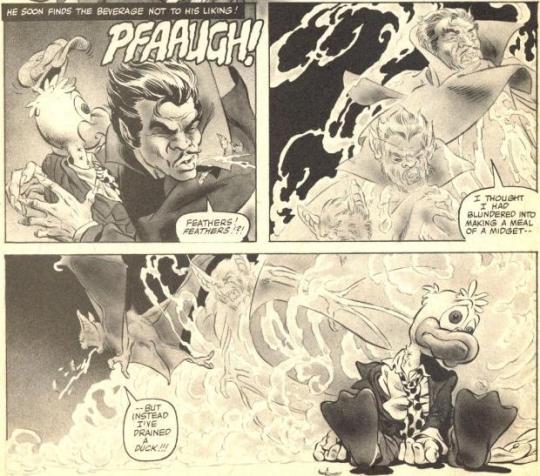
Dracula vs. Howard the Duck? (1980)
Howard the Duck Magazine #5
Not all Dracula appearances in the Marvel Universe are legendary but that doesn’t make them any less cool. The following is a treatise on why comics are awesome.
While visiting Cleveland, Dracula spots Howard the Duck. Thinking Howard to be a midget in a duck suit, the Lord of the Undead bites Howard (did I just type that?) but is disgusted by the non-human blood flowing in Howard’s veins. However, Howard is transformed into Drakula (not Duckula or Quakula?) and preys on other ducks.
read more: Upcoming Horror Movies Heading Your Way
Howard is restored to his normal self and is actually able to stake Dracula before the vampire can feed off Howard’s girlfriend, Beverly Switzer.
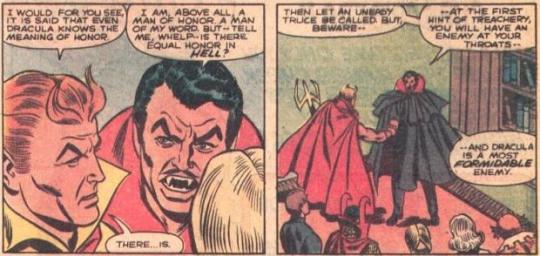
Dracula Joins The Defenders (1981)
Defenders #95
Ah, the Defenders. Long before they were edgy TV stars, they were the parking place for awesomely odd Bronze Age characters.
In one of the non-team’s most memorable storylines, the Defenders were being beleaguered by the Six Fingered Hand. With newer members Hellcat, Gargoyle, and Son of Satan in tow, the Defenders arrive back to Doctor Strange’s mansion only to be attacked by a possessed Dracula. It seems the Six Fingered Hand had gained control over all vampires.
Proving his awesomeness, the Son of Satan breaks the Hand’s control of Dracula, and agrees to help the Vampire Lord take back Transylvania from the Hand. The team with powerhouses like Strange and the Asgardian Valkyrie are just window dressing as the Son of Satan kicks the Hands' collective butts, destroys a metric ton of vampires by summoning sunlight, and saves Dracula’s undead bacon.
read more: 13 Essential Dracula Performances
This was the first time Marvel used Dracula as an anti-hero in a super-hero title, an honorable villain who was as comfortable in the role of defender of his people as he was bloodsucking fiend. It was a brief union, but among his many roles in the Marvel Universe, Dracula will always be recognized as a Defender.
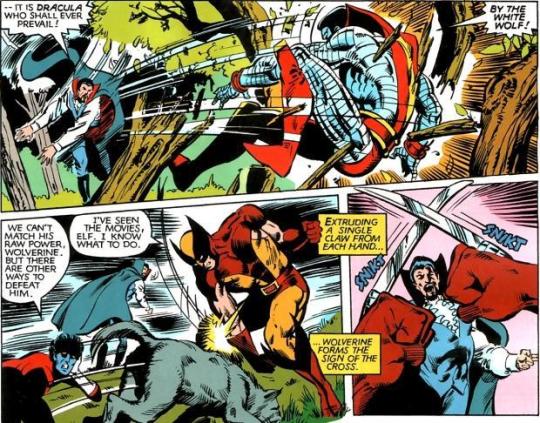
Dracula vs. The X-Men (1982)
Uncanny X-Men #159
Monster mash-ups are a staple of the genre. While not traditional monsters at all, mutants meeting Dracula have the same cache as Dracula versus Frankenstein or the Wolfman, it’s just a match made, erm...not in heaven.
Structured like a classic horror film, Uncanny X-Men #159 sees Storm the victim in a very odd mugging. When someone overpowered the weather goddess and cut her throat, Storm suddenly finds herself wanting to die, inviting a stranger through her window at night, drawing back from Kitty Pryde’s Star of David, and shunning sunlight. You don’t have to be Bram Stoker to see where this is going and an epic confrontation between vampire and mutant takes place. The X-Men take out Dracula’s monstrous rat and canine minions, but fall before Dracula, all except Nightcrawler who has the faith to drive the vampire off with a makeshift cross.
When Storm arrives, Dracula finds that he cannot control the primal Storm, who stands tall and proud. In an awesome moment, Dracula tells Storm it was her inner strength that compelled him and after a standoff, Dracula retreats. This was Claremont at his finest, giving each X-Man a moment to shine and writing a classic and pretty damn scary Dracula in the process. The issue created an indelible bond between the X-Men and Dracula, one that stands till this day.
read more: Frankenstein - Comics' Greatest Monster
In the 1982 Uncanny X-Men Annual #6, the battle between the X-Men and Dracula continues as Kitty Pryde is possessed by Dracula’s daughter and one of his most enduring foes, Lilith. It was another compelling confrontation that deepens the threat Dracula had on mutantkind.
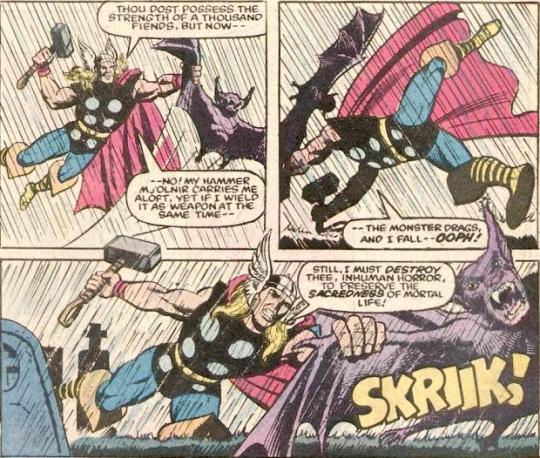
Dracula vs. Thor (1983)
Thor #332
Not satisfied with feeding off ducks, mutants, and wizards, Dracula sets his sights on embracing Lady Sif. In Thor #332, Dracula succeeds in feeding and turning Sif. In issue 333, Thor must face a Dracula empowered by god blood (comics = awesome), and an embraced Sif.
read more: The Best Horror Movies on Netflix
This story was significant in showing what a powerhouse Dracula was and established the idea that if Dracula fed off a non-human being, he would be fueled by their powerful blood. Thor managed to free Sif, but not before fans realized that Dracula was a threat to everyone, god, mutant, or human.
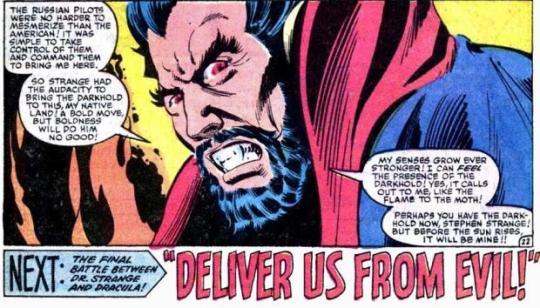
The Death of a Legend (1983)
Doctor Strange #59-62
In Doctor Strange #59-62, Strange and a group of companions including Dracula hunters Blade and the vampiric detective Hannibal King close all the plot threads left over from Tomb of Dracula and close the door on Marvel’s vampires for a quite a while. Aided by Avengers Captain Marvel (then Monica Rambeau) and the Scarlet Witch, Strange and company race to secure the Darkhold, a book which contains the Montessi Formula, a spell that will rid the Earth of Dracula and the curse of vampirism. Keep in mind that the Darkhold is an ancient magical book that created vampires in the first place.
read more: The Bleeding Heart of Dracula
These issues are the type of storytelling that made Stern a legend, taking elements from Dracula’s appearance in X-Men (the first mention of the Formula) and Thor (whom Dracula is reluctant in facing when he sees the other Avengers by Strange’s side). By the end of the story, Strange does recite the formula and Dracula is finally destroyed.
Like all good vampires, Dracula would eventually return, but the storyline has an epic sense of finality to it. After years of being plagued by Dracula, the Marvel heroes fight back destroying all vampires. For now…

Dracula vs. The Fantastic Four (2000-2001)
Before the Fantastic Four: The Storms
Dracula’s shadow is cast far and wide across the history of the Marvel Universe. Before they were legends, Sue Storm and Johnny Storm find a mysterious amulet. The young siblings are attacked by zombies seeking the amulet for its power, zombies controlled by none other than Dracula, who lays inert, staked and comatose, using his mind to control the zombies so they may deliver the amulet to the vampire.
read more: The Best Horror Movies on HBO
The Storms, before they were Fantastic, must stop the zombies from taking the amulet to Transylvania to resurrect their puppet master. Even immobile, Dracula proves to be one of the most evil and capable beings in the Marvel Universe.
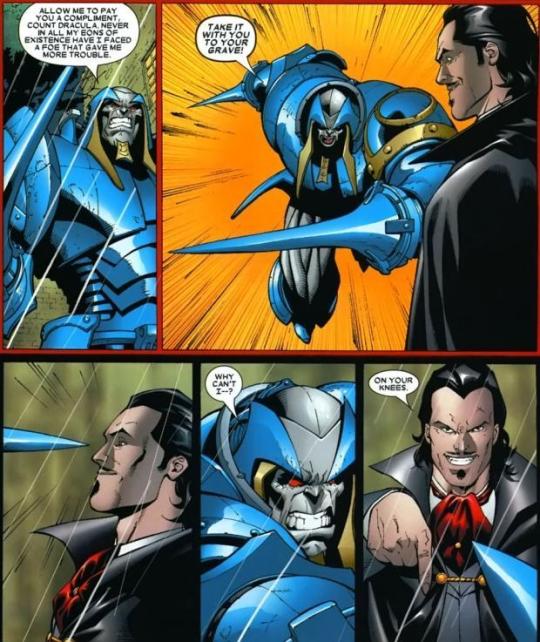
X-Men: Apocalypse vs. Dracula (2006)
The cool thing about this series is that it gave added weight to the idea that Dracula has had an impact on the history of the Marvel universe and that his ties to the world of mutants did not begin the day he tried to embrace Storm. Dracula begins embracing members of Apocalypse’s cult which wakes the legendary mutant to defend his followers. The book ties the history of the Van Helsing family into the war between mutant despot and vampire lord.
You can read it here.
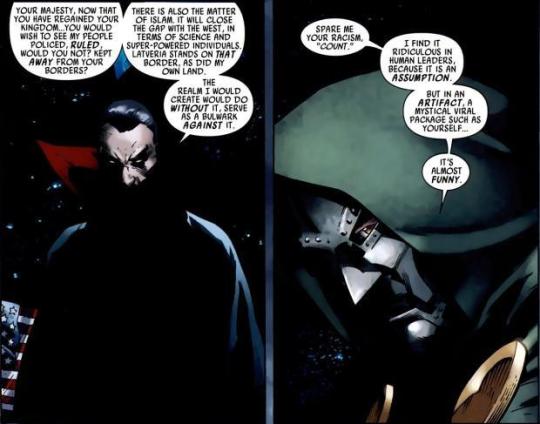
Dracula on the Moon (2009)
Captain Britain and MI:13 #10
The so-called end of vampires arc in Doctor Strange was a large scale storyline bringing in many mainstream Marvel mainstays, but it had nothing on the grand tapestry of cool that was the Dracula arc in the late, lamented Captain Britain and MI:13 title. So, Dracula gathers a sect of vampires on the moon to set up a front for his attack on Earth. Just typing that sentence was awesome. Dracula forms a non-aggression pact with Dr. Doom and only the magic of MI:13 led by Captain Britain and Pete Wisdom has a hope of stopping Dracula.
read more: The Best Horror Movies on Hulu
During the course of the arc, fans find out how brilliant Pete Wisdom is, that Dracula still holds a grudge against Muslims stemming back from his Vlad the Impaler days, that seeing Black Knight duel Dracula is pretty much better than anything else in the world, and that the legendary sword Excalibur wielded by a Muslim woman is more effective against Dracula than any crucifix.
Seriously, stop reading this and track down this storyline, we’ll wait.
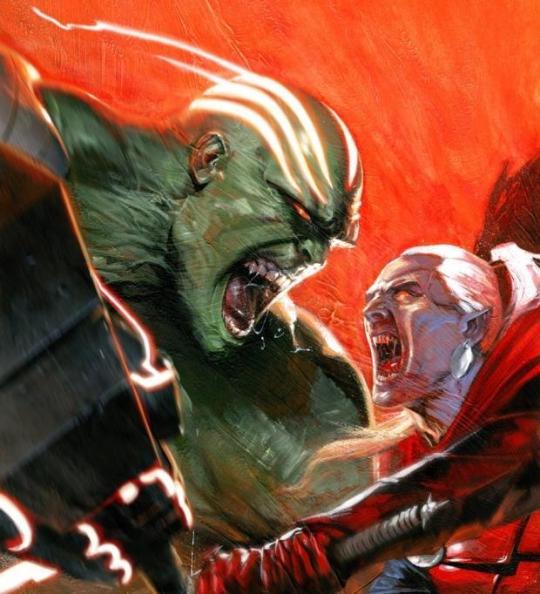
Hulk vs. Dracula
Part of the Fear Itself mega-event, this battle between two legendary monsters took a form fans did not expect. During the course of Fear Itself, the Hulk was transformed into Nul, the Breaker of Worlds. When Thor knocked Nul into the Carpathian Mountains, the Hulk became a threat to Dracula’s sovereignty. Once again taking up the mantle of reluctant defender, Dracula most take on Nul with a group of vampires, the Forgotten at his side. The event book was another step into the modern evolution of Dracula and was the first time he appeared alongside the Hulk.
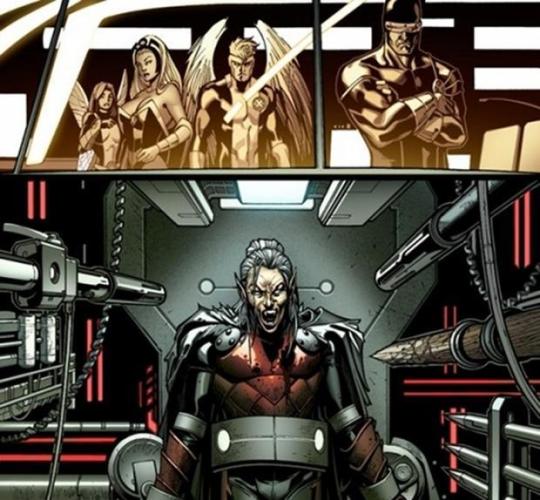
An X feud renewed (2011)
X-Men: Curse of the Mutants
Dracula’s return to the X Universe also served as the introduction of the modern interpretation of the Lord of the Undead. Gone is his rocking ‘stache and suave opera cape, arriving is the white hair and Coppola-esque armor. The story is pretty cool, if needlessly complex at times, and introduces Dracula’s son, Xarus. Xarus goes to war with dear old dad with the X-Men and a group of Atlanteans caught in the middle. The whole thing ends with a fierce reminder, family or not, do not mess with Dracula.
It's available on Amazon.
The new look for Dracula would stay consistent across all Marvel media as it was this look that appeared in an episode of Avengers Assemble on Disney XD. The story arc also brings vampirism closer to the X-Men as never before as Jubilee, once the most innocent of the X-Men, is transformed into a vampire. What Claremont and company began in the early '80s continues today as Dracula’s influence on the X-Men looms like a constant shadow over the heroes!
read more: 31 Best Streaming Horror Movies
Read and download the Den of Geek NYCC 2019 Special Edition Magazine right here!
facebook
twitter
tumblr
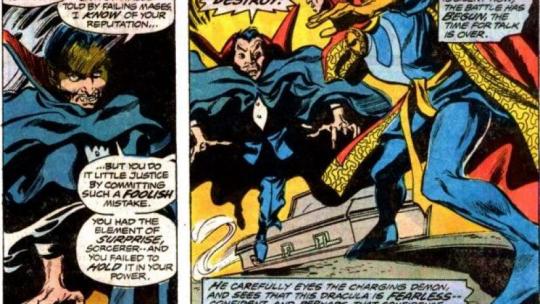
Feature Marc Buxton
Oct 20, 2019
Dracula
Doctor Strange
Marvel
31 Days of Horror
from Books https://ift.tt/2pzZdMQ
4 notes
·
View notes
Text
Some of these sources might be useful for anyone interested in indigenous Polynesian and Micronesian ethnobotany, folklore, and astronomy:
-
Abbott, Isabella A. “Polynesian Uses of Seaweed.” In Islands, Plants, and Polynesians: An Introduction to Polynesian Ethnobotany. Edited by Paul Alan Cox and Sandra Anne Bannack. Portland, Oregon: Dioscorides Press, 1991.
Alencar, Victor Aves. “Sky Observation and Mythology: Paths to an Astronomical Culture.” Proceedings of the International Astronomical Union Volume 5 Issue S260, 207-212.
Allen, Melinda S. “Coastal Morphogenesis, Climatic Trends, and Cook Islands Prehistory.” In Cultural Ecology in the Pacific Islands. Edited by Patrick V. Kirch and Terry L. Hunt. New Haven: Yale University Press, 1997.
Alpers, Antony. Legends of the South Sea: The World of the Polynesians seen through their Myths and Legends, Poetry and Art. New York: Thomas Y. Crowell Company, 1970.
Anderson, Atholl. “Epilogue: Changing Archaeological Perspectives upon Historical Ecology in the Pacific Islands.” Pacific Science 63:4 (2009).
Aswani, Shankar and Michael W. Graves. “The Tongan Maritime Expansion: A Case in the Evolutionary Ecology of Social Complexity.” Asian Perspectives 37:2 (1998).
Aveni, Anthony. People and the Sky (Our Ancestors and the Cosmos). New York: Thames and Hudson Inc., 2008.
Bannack, Sandra Anne. “Plants and Polynesian Voyaging.” In Islands, Plants, and Polynesians: An Introduction to Polynesian Ethnobotany, edited by Paul Alan Cox and Sandra Anne Bannack. Portland, Oregon: Dioscordes Press, 1991.
Beckwith, Martha. Hawaiian Mythology. Honolulu: University of Hawaii Press, 1977.
Black, Sharon, Thomas Wright and Lynnette Erickson. “Polynesian Folklore: An Alternative to Plastic Toys.” Children’s Literature in Education 32:2 (2001).
Buck, Peter H. Vikings of the Sunrise. New York: Stokes, 1938.
Burley, David V. “Archaeological Demography and Population Growth in the Kingdom of Tonga: 950 BC to the Historical Era.” In The Growth and Collapse of Pacific Island Societies: Archaeological and Demographic Perspectives. Edited by Patrick V. Kirch and Jean-Louis Rallu. Honolulu: University of Hawaii Press, 2008.
Connell, John. “Island Dreaming: The Contemplation of Polynesian Paradise.” Journal of Historical Geography 29:4 (2003).
Coppett, Daniel and Andre Iteanu. Cosmos and Society in Oceania (Explorations in Antrhopology). Oxford: Berg Publishers, 1995.
Couper, Alastair. Sailors and Traders: A Maritime History of the Pacific Peoples. Honolulu: University of Hawaii Press, 2009.
Crawford, Peter. Nomads of the Wind: A Natural History of Polynesia. London: BBC Books, 1993.
Cunningham, Sean P. “A Story of Yams, Worms, and Change from Ancestral Polynesia.” The Journal of Island and Coastal Archaeology 7:2 (2012).
D’Arcy, Paul. The People of the Sea: Environment, Identity, and History in Oceania. Honolulu: University of Hawaii Press, 2006.
Despland, Michel. “Two Ways of Articulating Outsider’s Knowledge of Polynesian Culture and Religion: Melville’s Typee and Mardi.” Method and Theory in the Study of Religion 16:2 (2004).
Devall, Bill and George Sessions. Deep Ecology: Living as if Nature Mattered. Layton, Utah: Gibbs Smith, 1985.
Edwards, Edmundo. “Astronomically-aligned Religious Structures on Raiatea and Raivavae and the Matariki Festival of 1770 on Easter Island.” Proceedings of the International Astronomical Union Volume 7, Symposium S278 (2011).
Eliade, Mircea. “Nostalgia for Paradise.” In The Inner Journey: Myth, Psyche, and Spirit (PARABOLA Anthology Series). Edited by Martha Heyneman. Series Editor: Ravi Ravindra. Sandpoint, Idaho: Morning Light Press, 2008.
Filihia, Meredith. “Shamanism in Tonga: An Assessment.” The Journal of Polynesian Society 117:4 (2008).
Finney, Ben. “Myth, Experiment, and the Reinvention of Polynesian Voyaging.” American Anthropologist 93:2 (1991).
Gladwin, Thomas. East is a Big Bird: Navigation and Logic on Puluwat Atoll. Cambridge, Massachusetts: Harvard University Press, 1970.
Glavin, Terry. The Last Great Sea: A Voyage through the Human and Natural History of the North Pacific Ocean. Vancouver, British Columbia: Greystone Books, 2000.
Gooley, Tristan. The Natural Navigator: The Rediscovered Art of Letting Nature Be Your Guide. New York: The Experiment, 2012.
Goto, Akira. “Archaeoastronomy and ethnoastronomy in the Ryuku Islands: A preliminary report.” Proceedings of the International Astronomical Union Volume 7, Symposium S278 (2011).
Grimble, Arthur. “Gilbertese Astronomy and Astronomical Observations.” Journal of the Polynesian Society 40 (1931).
Grimble, Arthur. Migrations, Myth and Magic from the Gilbert Islands. London: Routledge, 1972.
Groube, L.M. “Tonga, Lapita Pottery, and Polynesian Origins.” Journal of Polynesian Society 80:3 (1971).
Gunson, Niel. “A Note on Oceanic Shamanism.” Journal of the Polynesian Society 119:2 (2010).
Gunson, Niel. “Understanding Polynesian Traditional History.” The Journal of Pacific History 28:2 (1993).
Hamacher, Duane W. and Ray P. Norris. “‘Bridging the Gap’ through Australian Cultural Astronomy.” Proceedings of the International Astronomical Union Volume 7, Symposium S278 (2011).
Hames, Raymond. “The Ecologically Noble Savage Debate.” Annual Review of Anthropology 36 (2007).
Heyerdahl, Thor. Early Man and the Ocean (A Search for the Beginnings of Navigation and Seaborne Civilizations). Garden City, NY: Doubleday & Company, 1979.
Irwin, Geoffrey. The Prehistoric Exploration and Colonisation of the Pacific. Cambridge: Cambridge University Press, 1996.
Kahn, Miriam. “Tahiti: The Ripples of Myth on the Shores of the Imagination.” In History and Anthropology 11:4 (2003).
Kalakaua, His Hawaiian Majesty King David. “Hina: The Helen of Hawaii.” In The Legends and Myths of Hawaii. Edited by R.M. Daggett. Honolulu: Mutual Publishing, 1997.
Kelley, David H. and Eugene F. Milone. Exploring Ancient Skies: A Survey of Ancient and Cultural Astronomy. New York: Springer New York, 2011.
Kirch, Patrick V. “Changing Landscapes and Sociopolitcal Evolution in Mangaia, Central Polynesia.” In Historical Ecology in the Pacific Islands. Edited by Patrick V. Kirch and Terry L. Hunt. New Haven: Yale University Press, 1997.
Kirch, Patrick V. The Evolution of the Polynesian Chiefdoms. Cambridge: Cambridge University Press, 1984.
Kirch, Patrick V. “’Like Shoals of Fish’: Archaeology and Population in Pre-Contact Hawaii.” In The Growth and Collapse of Pacific Island Societies: Archaeological and Demographic Perspectives. Edited by Patrick V. Kirch and Jean-Louis Rallu. Honolulu: University of Hawaii Press, 2008.
Kirch, Patrick V. “Solstice observations in Mangareva, French Polynesia.” Archeoastronomy: the Journal of Astronomy in Culture 18 (2004).
Kirch, Patrick V. “Temple Sites in Kahi Kinui, Maui, Hawaiian Islands: Their Orientations Decoded.” Antiquity 78:299 (2004).
Kirch, Patrick V. and Jean-Louis Rallu. “Long-term Demographic Evolution in the Pacific Islands.” In The Growth and Collapse of Pacific Island Societies: Archaeological and Demographic Perspectives. Edited by Patrick V. Kirch and Jean-Louis Rallu. Honolulu: University of Hawaii Press, 2008.
Ladefoged, Thegn N. and Michael W. Graves. “Modelling Agricultural Development and Demography in Kohala, Hawaii.” In The Growth and Collapse of Pacific Island Societies: Archaeological and Demographic Perspectives. Edited by Patrick V. Kirch and Jean-Louis Rallu. Honolulu: University of Hawaii Press, 2008.
Lessa, William A. “Origins.” In More Tales from Ulithi Atoll: A Content Analysis. Edited by William A. Lessa. Berkely: University of California Press, 1980.
Lewis, David. “A Return Voyage between Puluwat and Saipan using Micronesia Navigational Techniques.” Journal of Polynesian Sociology 80:4 (1971).
Lewis, David. “Voyaging Stars: Aspects of Polynesian and Micronesian Astronomy.” Philosophical Transactions of the Royal Society of London: Series A, Mathematical and Physical Sciences 276:1257 (1974).
Lewis, David H. We, the Navigators: The Ancient Art of Landfinding in the Pacific. London: Angus and Robertson, 1972.
Luomala, Katharine. Ethnobotany of the Gilbert Islands. Honolulu: Bernice P. Bishop Museum, 1953.
Magli, Giulio. Mysteries and Discoveries of Archaeoastronomy (From Giza to Easter Island). New York: Copernicus Books, 2009.
Makemson, Maud Worcester. The Morning Star Rises: An Account of Polynesian Astronomy. New Haven: Yale University Press, 1941.
Malnic, Jutta with John Kasaipwalova. Kula: Myth and Magic in the Trobriand Islands. Wahroonga, NSW: Cowrie Books, 1998.
Mawyer, Alexander. “The Oceanic Drift in Polynesian Linguistics.” Language and Communication 28:4 (2008).
McLuhan, T.C. The Way of the Earth: Encounters with Nature in Ancient and Contemporary Thought. New York: Simon and Schuster, 1994.
Mercer, P.M. “Oral Tradition in the Pacific: Problems of Interpretation.” The Journal of Pacific History 14:3 (1979).
Neves-Graca, Katja. “Elementary Methodological Tools for a Recursive Approach to Human-Environmental Relations.” In Person, Space and Memory in the Contemporary Pacific: Volume 1: Experiencing New Worlds. Edited by Jurg Wassmann and Katharina Stockhaus. Oxford: Bergham Books, 2007.
Nunn, Patrick D. “Fished Up or Thrown Down: The Geography of Pacific Island Origin Myths.” Annals of the Association of American Geographers 93:2 (2003).
Nunn, Patrick D. “On the Convergence of Myth and Reality: Example from the Pacific Islands.” The Geographical Journal 167:2 (2001).
Oliver, Douglas L. Ancient Tahitian Society: Social Relations. Honolulu: University of Hawaii Press, 1974.
Oliver, Douglas L. Oceania (The Native Cultures of Australia and the Pacific Islands). Honolulu: University of Hawaii Press, 1989.
Penprase, Bryan E. The Power of Stars (How Celestial Observations Have Shaped Civilization). London: Springer, 2011.
Poignant, Roslyn. “Polynesia.” In Oceanic Mythology: The Myths of Polynesia, Melanesia, Australia. Edited by Roslyn Poignant. London: Paul Hamlyn, 1967.
Ragone, Diane. “Ethnobotany of Breadfruit in Polynesia.” In Islands, Plants, and Polynesians: An Introduction to Polynesian Ethnobotany. Edited by Paul Alan Cox and Sandra Anne Bannack. Portland, Oregon: Dioscorides Press, 1991.
Rallu, Jean-Louis. “Pre- and Post-Contact Population in Island Polynesia: Can Projections Meet Retrodictions?” In The Growth and Collapse of Pacific Island Societies: Archaeological and Demographic Perspectives. Edited by Patrick V. Kirch and Jean-Louis Rallu. Honolulu: University of Hawaii Press, 2008.
Ryan, Anna. Where Land Meets Sea: Coastal Explorations of Landscape, Representation and Spatial Experience. Farnham, England: Ashgate Publishing Limited, 2012.
Sahlins, Marshall D. Social Stratification in Polynesia. Seattle: University of Washington Press, 1958.
Smith, W. Ramsay. Myths and Legends of the Australian Aborigines. Mineola, New York: Dover Publications, Inc., 2003.
Stone, Benjamin C. “The Role of Pandanus in the Culture of the Marshall Islands.” In Plants and the Migrations of Pacific Peoples: A Symposium. Edited by Jacques Barrau. Honolulu: Bishop Museum Press, 1963.
Strathern, Andrew and Pamela J. Stewart. “Actors and Actions in ‘Exotic’ Places.” In Person, Space and Memory in the Contemporary Pacific: Volume 1: Experiencing New World. Edited by Jurg Wassmann and Katharina Stockhaus. Oxford: Bergham Books, 2007.
Suggs, Robert C. The Island Civilizations of Polynesia. New York: The New American Library, 1960.
Titcomb, Margarex (with the collaboration of Mary Kawena Pukui). Dog and Man in the Ancient Pacific with Special Attention to Hawaii. Honolulu: Bernice P. Bishop Museum, 1969.
Tuljapurkar, Shirpad, Charlotte Lee and Michelle Figgs. “Demography and Food in Early Polynesia.” In The Growth and Collapse of Pacific Island Societies: Archaeological and Demographic Perspectives. Edited by Patrick V. Kirch and Jean-Louis Rallu. Honolulu: University of Hawaii Press, 2008.
Williamson, Robert W. Religious and Cosmic Beliefs of Central Polynesia. London: Cambridge University Press, 1933.
Winduo, Steven Edmund. “Unwriting Oceania: The Repositioning of the Pacific Writer Scholars within a Folk Narrative Space.” New Literary History 31:3 (2000).
Whistler, Dr. W. Arthur. Polynesian Herbal Medicine. Lawai, Hawaii: National Tropical Botanical Garden, 1992.
-
My first thesis was about Oceanian environmental knowledge. These are some of the better references I have come across. Two of the most authoritative researchers of early Polynesian knowledge are David Lewis (expert on wayfinding) and Patrick V. Kirch (expert on ethnobotany and land-use); they dominate most bibliographies on the subject. I also like the work of Patrick Nunn, who focuses more on Polynesian folklore.
5 notes
·
View notes
Text


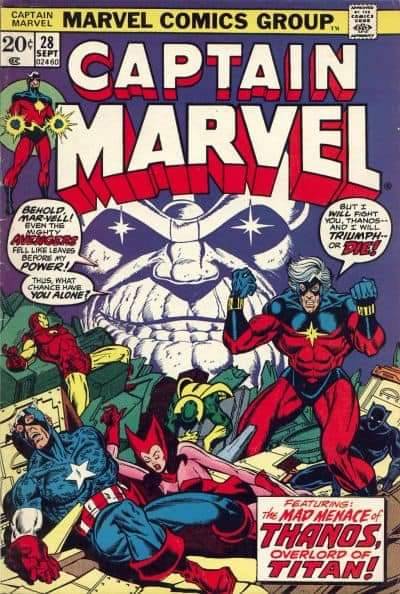


James P. Starlin (born October 9, 1949 🥳) is an American comics artist and writer. Beginning his career in the early 1970s, he is best known for space opera stories, for revamping the Marvel Comics characters Captain Marvel and Adam Warlock, and for creating or co-creating the Marvel characters Thanos, Drax the Destroyer, Gamora, and Shang-Chi.
Starlin was born in Detroit, Michigan, raised Catholic, and in the 1960s, served as an aviation photographer for the US Navy in Vietnam. During his off duty time, he drew and submitted various comics. Starlin was part of the generation of artists and writers who grew up as fans of Silver Age Marvel Comics. At a Steve Ditko-focused panel at the 2008 Comic-Con International, Starlin said, "Everything I learned about storytelling was [due to] him or Kirby. [Ditko] did the best layouts."
After leaving the Navy, Starlin sold two stories to DC Comics and having written and drawn stories for a number of fan publications, Starlin entered the comics industry in 1972, working for Roy Thomas and John Romita at Marvel Comics.
Starlin's first job for Marvel was as a finisher on pages of The Amazing Spider-Man. He then drew three issues of Iron Man, that introduced the characters Thanos and Drax the Destroyer. He was then given the chance to draw an issue (#25) of the "cosmic" title Captain Marvel. Starlin took over as plotter the following issue, and began developing an elaborate story arc centered on the villainous Thanos, and spread across a number of Marvel titles. Starlin left Captain Marvel one issue after concluding his Thanos saga.
Concurrently in the mid-1970s, Starlin contributed a cache of stories to the independently published science-fiction anthology Star Reach. Here he developed his ideas of God, death, and infinity, free of the restrictions of mainstream comics publishers' self-censorship arm, the Comics Code Authority. Starlin also drew "The Secret of Skull River", inked by frequent collaborator Al Milgrom, for Savage Tales #5 (July 1974).
After working on Captain Marvel, Starlin and writer Steve Englehart co-created the character Shang-Chi, Master of Kung Fu, though they only worked on the early issues of the Master of Kung Fu series. Starlin then took over the title Warlock, starring a genetically engineered being created by Stan Lee and Jack Kirby in the 1960s and re-imagined by Roy Thomas and Gil Kane in the 1970s as a Jesus Christ-like figure on an alternate Earth. Envisioning the character as philosophical and existentially tortured, Starlin wrote and drew a complex space opera with theological and psychological themes. Warlock confronted the militaristic Universal Church of Truth, eventually revealed to be created and led by an evil evolution of his future–past self, known as Magus. Starlin ultimately incorporated Thanos into this story.
Comics historian Les Daniels noted that "In a brief stint with Marvel, which included work on two characters [Captain Marvel and Adam Warlock] that had previously never quite made their mark, Starlin managed to build a considerable cult following."
Starlin was given the opportunity to produce a one-shot story in which to kill off a main character. The Death of Captain Marvel became the first graphic novel published by Marvel itself.
Starlin and Bernie Wrightson produced Heroes for Hope, a 1985 one-shot designed to raise money for African famine relief and recovery. Published in the form of a "comic jam," the book featured an all-star lineup of comics creators as well as a few notable authors from outside the comic book industry, such as Stephen King, George R. R. Martin, Harlan Ellison, and Edward Bryant. In 1986, he and Wrightson produced a second benefit comic for famine relief. Heroes Against Hunger, featuring Superman and Batman, was published by DC and like the earlier Marvel benefit project featured many top comics creators.
Starlin became the writer of Batman and one of his first storylines for the title was "Ten Nights of The Beast". Starlin then wrote the four-issue miniseries Batman: The Cult (Aug.–Nov. 1988) drawn by Wrightson, and the storyline "Batman: A Death in the Family", in Batman #426–429 (Dec. 1988 – Jan. 1989), in which Jason Todd, the second of Batman's Robin sidekicks, was killed by the Joker. Starlin was fired off the Batman title soon afterward.
Back at Marvel, Starlin began scripting a revival of the Silver Surfer series. As had become his Marvel norm, he introduced his creation Thanos into the story arc, which led to The Infinity Gauntlet miniseries and its crossover storyline. Here, Starlin brought back Adam Warlock, whom he had killed years earlier in his concluding Warlock story in The Avengers Annual #7 and Marvel Two-in-One Annual #2 in 1977. The Infinity Gauntlet proved successful and was followed by the sequel miniseries The Infinity War and Infinity Crusade.
- In Fall 1978, Starlin, Howard Chaykin, Walt Simonson, and Val Mayerik formed Upstart Associates, a shared studio space on West 29th Street in New York City. The membership of the studio changed over time.
- Starlin created an expansive story titled "the Metamorphosis Odyssey", which introduced the character of Vanth Dreadstar in Epic Illustrated #3. From its beginning in Epic Illustrated, the initial story was painted in monochromatic grays, eventually added to with other tones, and finally becoming full color. The storyline was further developed in The Price and Marvel Graphic Novel #3 and eventually the long-running Dreadstar comic book, published first by Epic Comics, and then by First Comics.
- Death and suicide are recurring themes in Starlin's work: Personifications of Death appeared in his Captain Marvel series and in a fill-in story for Ghost Rider; Warlock commits suicide by killing his future self; and suicide is a theme in a story he plotted and drew for The Rampaging Hulk magazine.
#marvel #jimstarlin #writer #thanos #captainmarvel #space #sciencefiction #marvelcomics #spaceopera #marveluniverse #gamora #ShangChi #marvel89 #death #batman #infinitygauntlet #rampaginghulk #batmanandrobin #dccomics #marvel6189 #mcu #infinitywar #robin #Joker #illustration #DreadStar #ghostrider #creativewriting #popculture
0 notes
Text
The Yorkshire Ripper Back Story podcast link here - https://www.buzzsprout.com/1016881/6357289
Speaker 1: (00:00)
[inaudible]. Yes.
Dana Lewis / Host : (00:19)
Hi everyone. And welcome to backstory. I'm Dana Lewis in 1980, I was a crime reporter in Toronto, in England. A chilling frightening story was unfolding. A man who was stalking and killing women dubbed the Yorkshire ripper. That's where he was lurking Yorkshire, England in towns, Lake Bradford, Sheffield Lee. He killed 13 women and attempted to murder seven more. He was eventually caught his name, Peter Sutcliffe. And this week Sutcliffe serving 20 concurrent sentences for life. Imprisonment died from COVID-19. In 1980, I told my boss his name was Robert holiday. Let me go and cover the murders. I paid my airfare and hotels and told the news director, if you like the story, I bring back, just pay my airfare. And that's what happened on my vacation time. This is the story I did way back then in the end, the story I prepared for a national radio show called Sunday, Sunday aired just as Peter Sutcliffe was caught and his terrible murder spree came to an end. I got my story and 600 bucks for the air ticket. I was only 20. This is what I sounded like. And that's the way it was. Hell of a crime story.
Speaker 1: (01:39)
[inaudible] yes, I won't say when, but yes, we will catch him. It's got a nice background to support. So when you can't live on 23 pound a week with two kids, sorry, it's not possible. So you're willing to take the chance of the ripper in order to feed your family into social skills. Well, I did come up the stock Hill girls, innocent girls as well. He come up from the other channels. You could be Jack. I could be Jack the ripper it's as difficult as that from ABC news. I'm Bob Windsor, British police might have caught up with a murderer called the Yorkshire ripper. I was terrorized Northern England for five years by killing 13 women police in West Yorkshire arrested two days ago about the murder Pharaoh. The feeling
Speaker 3: (03:00)
Is that, um, it is most likely on the time that they spend in the red. So they thought the beginning of a new one, which would be well or a new red is, um, now discovering. Um, how and why and who
Dana Lewis / Host : (03:13)
West Yorkshire police think they know who they have charged. 35 year old truck driver, Peter Sutcliffe with murder number 13. He has been remanded in custody until tomorrow. There are many clues as to how the murders were committed. There are few that indicate why friends and neighbors of Sutcliffe say he was a quiet man. They are surprised. That's the thing about your church. Friends and neighbors are easy to come by. It's a large area, but it has that small town atmosphere, Yorkshire views itself as a nation. It was the largest County in England until it was quartered in 1974. It's towns folk have produced textiles since the 18th century and that unmistakable scent of black coal fills the air. Although the rolling countryside could be sold in a travel magazine, the towns and cities of the area are bleak and gray. The people hardworking and conservative. The Yorkshire ripper has left the area in shock.
Speaker 5: (04:15)
The first victim that we attributed to them on this now locally known as the AKI Rippa was in fact, Anna Rogowski. She was a 37 year old woman who was walking through the streets in the early hours of the face of July, 1975. She was walking through the streets of Keithley when she was, um, struck about the head, attacked with a number of blows and left unconscious.
Dana Lewis / Host : (04:37)
The ripper began his spree of killings in the town of Leeds, October 30th, 1975, 28 year old Wilma McCann was struck over the head and stabbed savagely. The ripper was born and the stage set for Britain's worst mass murderer. During the next five years of the ripper would allude Britain's best detectives. It would attack 17 girls in total leaving 13 dead for police superintendent, Frank Mort. It was the largest investigation he would ever be involved in. I had come to you five years ago and suggested that, uh, a killer as bold, as vicious as this could elude you for so much time. Would you believe me?
Speaker 5: (05:15)
No, I don't think I would. Um, if you would have said to me that yes, we might have a mass murderer. Yes, I would have believed that. But if you would have tone, tried to suggest to me that a murderer could have, in fact, committed 13 violent and vicious attacks and left solidly behind that I would have found difficult to accept. Um, but events have proved. In fact, that we have a man who is capable of doing that,
Dana Lewis / Host : (05:38)
He seems to be able to lead these women away. Does he not, or at least approach them without causing them to run?
Speaker 5: (05:44)
Yeah, that's, that's one version that you could could attach to it. The other one, and the one that I prefer to think is probably the, the way he operates is not necessarily to pursue them for long distances, but maybe to stand in some secluded shop doorway or some secluded yard entry. Um, and when the woman passes email, you need to perhaps take one or two steps to strike the blow. Uh, so far as the prostitute was concerned, yester, I think it's fairly clear that, uh, he would pick the woman OPA as a normal customer would pick up a prostitute and drive to a secluded area, which either he or she nominated and committed the crime, uh, was this one. He would pick the area and wait for the girl to come into that area. I, in the past of like an M a little bit to the spider who picks his area, and then he sits quiet and waits. And when the fly comes by he'll snap, and I think the same principle applies here. He will pick it out here and he will wait until those circumstances are exactly right. And the girl comes along and then he will attack. And if the circumstances are not right, then that girl continued on her way.
Speaker 5: (06:54)
We're now into the 20th of January, 1976, when bucking leads the body of Emily Jackson, the 42 Ariel prostitute was found. She had been stabbed and beaten about the head many, many times. That was the first real indication perhaps that we had, um, a one-man killer and all one monitor attack, a woman that was working in a number of areas of the country.
Speaker 1: (07:18)
[inaudible]
Dana Lewis / Host : (07:24)
Besides a cassette tape, three letters were also sent to assistant chief, Constable George Oldfield from a man. Police believed was the ripper, the material criticized old field. Then in charge of the man hunt and his team of detectives.
Speaker 1: (07:39)
I can't see any sharp pain. Nick, just checking for fingerprints. You shouldn't know, by now it's painted in with some .
Dana Lewis / Host : (08:03)
The cassette tape gave the case a new mystery. It was dramatic. Some say spine chilling and investigator search for its author. Loudspeakers played at a gain and a gain from town to town in the hope someone would recognize the man behind the voice, the tapes and letters to police. What sort of a man does that?
Speaker 6: (08:25)
I think it's the kind of man who fits in with my hypothesis of him being a psychopath. It was fascinating to me too, to watch how it unfolded really how there seemed to be developing a battle of wits between mr Oldfield and this murderer to such an extent that he felt emboldened enough to send a tape and a letter now to digress for a minute. I think that was a mistake.
Dana Lewis / Host : (08:50)
Dr. Steven Shaw was one of several psychologists called into assist in ripper hunt in 1973, his work with the criminally insane expensive.
Speaker 6: (09:00)
So these are mistakes and a psychopath does make his mistakes and he doesn't learn from them, but he cannot resist the impulse. And that was another of my features cannot resist the impulse to have a battle of wits with mr. Oldfield. So has to taunt him has to send the tapes to say, I've got the respect for you, mr. Oldfield, but your boys are not much good. I am better than the whole of the West Yorkshire police, as it were almost crowing over them, challenging them to,
Dana Lewis / Host : (09:28)
It appears the Yorkshire police department has finally met that challenge and beaten the ripper at his game. There is a second half to this story besides the police and the ripper. There are the people of that area. There's is the real story in this tale.
Speaker 5: (09:48)
The ripper, in fact, didn't strike again for another 381 days. And then on the 5th of April, 1977, um, Irene Richardson, she was killed in Leeds and that's when the local media first started using the title, the ripper. Um, it didn't stop him killing. However, because he moved into Bradford and on the 23rd of April, 1977, Patricia Atkinson, um, she was killed 63 days later, he came back to leads and on the 26th of June, he killed a young 16 year old girl Jane McDonald. And this was the first of the women who were not in fact, a prostitute or a lawnmower
Dana Lewis / Host : (10:28)
As the ripper taunted, and played his deadly game with the people of Yorkshire. The area changed drastically, Oh no, not the buildings or landscape, but as residence in daytime hours, conversations were filled with tales of the ripper, who we might be, what he was doing. And when he might do it again at night, a terrified County locked its doors and fear cab drivers could see the change.
Speaker 7: (10:53)
It takes David like the suit to Lee's chapel town, or used to be not similar to, since the, um, since the murders, the, uh, the girls have tended to move out of laser just to cherries. Is that fair?
Dana Lewis / Host : (11:05)
Garth? What would I have found a five years ago? If you would've been driving me through this area
Speaker 7: (11:11)
Five years, you have found a lot, lots of activity. Basically. You see it, you would have seen the girls on the street corners, the punch of cars, driving around the streets, looking for the girls, basically just bunch of activity, which you don't see in alleys. It's just practically deserted. Since I've been taxing, I've met a good living out of it, but now I'm just barely making living. It's just so quiet. It's really,
Dana Lewis / Host : (11:42)
The red light areas were so quiet. It took me four days to find any prostitutes with the courage to work the area. When I did find them, it was under a street lamp and a broken down of the rippers, hometown
Speaker 1: (11:54)
Of Bradford there. The girls worked in pairs or not at all finished what's happened. There's no claims anymore. It's dead. Just pure, please. Just a lot of police. Are they giving you a hard time? Not really. They're just everywhere all the time. So a lot of the guys not coming around and there's no, no. Don't you get a little scared though. Yeah, but I don't work alone. I work with her two girls, whoever gets the client, you know, if they don't want, until they're the ones still goes, most girls now work away. Our town, wherever they gun London, pick towns, knowledge, London, Scotland, Ireland. Even because of the river. They were. Yeah. Yeah. Not just because they were afraid that because there's no money there anymore. Well, why don't the customers come up though? Is it because the police had given him a haircut? The police like do spot checks a lot and it's very, and when they've got family or police, aren't discreet about it, they just go knock on door and say in front of the wife, they'd been on pink, red light, or they'd been seen it's like, it used to be a spot check.
Speaker 1: (13:02)
And every car that came up here, it got checked out thoroughly. And to do that, they used to go to clients' homes, even the works and see the money driven state for the wives. So I'm not sure they can't afford that. Started scouting or sort of just stopped coming through that as well. It's dead. It is quiet. And it's like this every night now it's been like this past few weeks. The main thing is if you're a prostitute, wherever you go, this place, it's because there's no money. And what she was getting locked up for nothing. That's why they're going away. They're still getting locked up somewhere, but at least their own in the moment. Yeah. Well, how do you, how do you girls feel about the police? All right. Are you mad at them for doing well? They're doing the Japanese. So they try and protect us only for police on a red light area, rip a beer outside.
Speaker 1: (13:50)
That's the way I think that's the reason he's turned to straight people because he knows now not to come up cause he's gone and get spot checks or whatever it is. There's too many police now. So he's turned into straight people to do them. Yeah. Do you think about the river when you're standing out here at night? It's always a, it's always that because we know lots of the people. Not only have people been killed in your community, not only are girls really scared to go out on the streets at night, but when a girl, a prostitute, you know, well, just, just not someone you work with a friend of yours, it happens to her. Doesn't that make you want to quit? It does. Yeah, but you can't quit. I couldn't quit. Look at it this way. Right? All laws is one parent families. She has two kids. I have two. She's got three. Yeah. We don't have no fellow behind doors. Normally sports, as we've got, as renters, food is closed. Then you get all 23% of social security a week. I'm can you live? You can't live. So you're willing to take the routes. Well, you have to do, it's not a much a willing to take it as a matter of live in it's a mantra that you have taken that risk for your kids to start when going get put into care.
Speaker 5: (14:59)
And then there was another, and in fact, the longest gap of all, he went 441 days before he moved back to leaves and the latest victim Jacqueline Hill, and she was killed on the evening of the 17th of November, 1980. And again, she was beaten about the head
Dana Lewis / Host : (15:15)
From the Bradford red light district to elite pump. The feeling was the same. No one could escape the grip of the ripper like this man, all wondered if at one time or another, they had looked the killer right in the ear.
Speaker 1: (15:28)
They tool to each other about it because you may be talking to the ripper. That's the feeling then it, sorry. Many people have said though, that this is the feeling around here. And in fact, in the whole of Bradford, you mean people are so scared that they're looking at anyone they talk to. And wondering if he's the ribbon.
Dana Lewis / Host : (15:49)
By the time I arrived in Yorkshire to gather this story, 13 murders had been recorded. Towns. People were awaiting. The next one, the families and relatives of the victims were tired, broken, and would not talk to reporters. But given the chance by the BBC to talk directly to the ripper, they took it. Mrs. Irene MacDonald, her daughter was murdered in 1977.
Speaker 1: (16:13)
It was a beast with no feelings. And you're a coward. Why do you come up with stock? Young girls, innocent girls as well. You'd come up from behind them, the door, other chance. You're not a man. You're a beast. And I heard too. And I believe all the population and leads and everywhere too. I wonder who you think you are. Do download. Think y'all God or something. God give life. God take us away. Not you. I think you are the devil itself.
Dana Lewis / Host : (16:51)
Mrs. Patricia Brandenburg, her niece was murdered in 1977.
Speaker 1: (16:56)
Jane was a beautiful girl. You took life from her. You destroyed a family in one way or another. A father just deteriorated. You're nuts. So mad. He despicable. I despise you intensely. Every living person curses you, you can't even dig a hole for yourself because people would come and find you and drag you out.
Dana Lewis / Host : (17:18)
Mr. Harry smelled, his wife was attacked in 1975
Speaker 5: (17:22)
Of all the women you've killed. I think if you were to take a census of them all, I think given the opportunity to do, as you wish with them, I think they would rate you pretty low sexually. I think that's what it's all about. You you're proving. You're a man by killing them. Most men don't have to kill a women to prove that they're a man. Let's talk about real crimes, organizing bank robberies and on. And I think you will be really a non runner. It tends to be women and it has to be
Dana Lewis / Host : (17:55)
Behind mr. Hayden, highly. His daughter was murdered in 1979.
Speaker 5: (18:00)
You are the lowest of the low. You did mention, uh, believers in your tape to the police that you want it to be mentioned in the Guinness book of records. I'll go along with that, you should be classed as the biggest coward the world has ever known. That's in the Guinness book of records,
Dana Lewis / Host : (18:23)
Mrs. Barrel leech, her daughter murdered in 1979.
Speaker 5: (18:28)
Look over your shoulder. You hit him from behind. The number is tango uniform. Mike nine eight, three Romeo, probably three ways that the murder could be brought to justice. Number one is it could be some super detective, um, as a blinding flash of genius as a result of which the man is arrested. Yeah. That's possibility. Number one, possibility. Number two is that the grind, the day-to-day slug, uh, will bring results because of the painstaking tedious, very involved and very detailed inquiries. There is also the third way, and that is that some policeman, uh, doing some duty, totally unconnected with the ripper inquiry will. In fact, what round the corner and walk straight into the Manor.
Dana Lewis / Host : (19:29)
Superintendent. Frank Moritz predictions given to me several weeks ago. We're not that far off 35 year old Peter Sutcliffe was arrested. Nine days ago, two constables on routine patrol. And the red light district of Sheffield stopped a car driven by Sutcliffe in his company. A lady of the night, the license plates were checked and found to be stolen. One thing led to another and by the beginning of the week, it was announced the truck driver would stand trial for the murder of the rippers 13th victim. After interviewing over 200,000 people searching 30,000 homes at a cost of $10 million. The 500 man ripper squad has disbanded. The people of your chair will not return to the norm quite so easily. This is Dana Lewis. Eventually those tapes, the police played from town to town were proven to be fake. It wasn't Sutcliffe, but it did distract the police from catching the real killer for a while. How was Sutcliffe finally caught the two policemen who stopped him on a routine check? One of them felt suspicious when the man has to relieve himself. The officer went around to the scene later and found that Sutcliffe had dropped a hammer and knife on the ground. And that was the end of the Yorkshire ripper string of murders
Dana Lewis / Host : (20:48)
This week, victims of his attempted murders and families of those who were killed, spoke out to say they won't shed a tear for Sutcliffe's passing, but his death brings about closure to a bloody and terrifying period in Yorkshire. I'm Dana Lewis. Thanks for listening to backstory. Please subscribe to the best international news podcast and share our link. Take care. And I'll talk to you again soon.
0 notes
Text
Fantasy and Adventure New Releases, 27 April 2019
Fighter jocks, secret conspiracies, elemental academies and Cleopatra’s tomb all feature in this week’s roundup of the newest releases in fantasy and adventure.
Alt-Hero: Q #1: Where We Go One – Chuck Dixon and Helix Haze
When federal agent Roland Dane is sent to Peru to escort a U.S. Cabinet member, he has no reason to believe his assignment is connected in any way to his Treasury team’s recent bust of a ring of amateur counterfeiters. But when the Secretary of State and his entourage is unexpectedly attacked and the subsequent news reports of the attack bear no resemblance to the events he witnessed, Dane is forced to confront the shocking discovery that nothing in his world is quite what it appears to be.
Alt★Hero: Q is an incendiary comic series that explores the mysterious phenomenon of QAnon. Set in the Alt★Hero universe, the story is written by The Legend Chuck Dixon, the co-creator of Bane and the most prolific author in the history of comic books.
The Earth Awakens (Elemental Academy #2) – D. K. Holmberg
Having passed his first test at the Academy, most believe Tolan has proved he belongs. Only Tolan knows the truth: that his shaping required power from the borrowed bondar—and possibly from the elementals themselves. If he can’t find a way to shape without one, he’ll be expelled from the Academy.
When he intervenes to stop another attack on the city, he once again finds himself in the middle of the battle between Terndahl and the Draasin Lord. Worse, because of his continued reliance on the bondars, he begins to fear he might be responsible for releasing elementals.
Another test approaches. For him to remain at the Academy, he must find real power within himself, but a greater challenge distracts him. With increased attacks on the city, Tolan might be the only one to know what they’re after—and how to stop them.
Lions of the Sky – Paco Chierici
Sam Richardson is a fighter pilot’s pilot,i a reluctant legend with a gut-eating secret. He is in the last span of his tour as an instructor, yearning to get back to the real action of the Fleet, when he is ordered to take on one last class—a class that will force him to confront his carefully quarantined demons.
Brash, carefree, and naturally gifted, Keely Silvers is the embodiment of all that grates on him. After years of single-minded dedication, she and her classmates can see the finish line. They are months away from achieving their life-long dream, flying Navy F/A-18 fighters. They are smart and hard-working, but they’re just kids with expensive new toys. They’re eager to rush through training and escape to the freedom of the world beyond, a world they view as a playground full of fast jets and exotic locales.
But Sam knows there is a darker side to the profession he loves. There is trouble brewing in the East with global implications. If they make it past him they will be cast into a dangerous world where enemy planes cruise the skies over the South China Sea like sharks, loaded with real weapons and hidden intentions.
The Lost War – Karl Gallagher
It was supposed to be a weekend of costumed fun. Instead these medieval historical reenactors are flung into a wilderness by magic they don’t understand. They must struggle to survive and deal with monsters who consider them prey . . . or worse.
“Karl Gallagher’s first production, the Torchship Trilogy, was good enough so that I read and reread it. He has now turned his hand from science fiction to fantasy.” – Professor David D. Friedman, Professor, Santa Clara University, also known as Duke Cariadoc of the Bow, KSCA, OL, OP, founder of the Pennsic War.
“Highly recommended for those who enjoy watching a group fighting for their own survival on a sticks-and-stones level of technology in a brand-new world which has magic (and to make it more interesting some in the group are becoming magic users themselves)!”–Amazon Reader Review
The King’s Enemies (The Henchmen Chronicles #5) – Craig Halloran
In the final inning Abraham must shut the enemy out or die.
The invasion begins with an enemy the likes the people of Titanuus have never imagined. Armed modern weaponry, diabolical forces muster at the Kingsland border wall, while savage barbarian forces called the Gond, secretly lay siege upon the House of Steel.
With the Crown of Stones incomplete and the king slipping into madness more treachery bears fruit as former alliances are broken and old enemies rise again.
Outgunned and overmatched, Abraham Jenkins, must use his wits and sword to bring the enemy down before the curtain closes and he is trapped dead or alive in Titanuus forever.
Savage Sword of Conan: The Original Marvel Years Omnibus Vol. 1 – presented by Marvel Comics
Crom! This inaugural volume ushers in Marvel’s line of definitive Savage Sword of Conan collections. Full-color covers, letters pages, pinups, extensive articles and reviews on Conan, his world and his creator -everything’s included just as no one is spared the vengeance of Conan! After the breakout success of Conan’s color comic, Marvel brought the legendary sword-and-sorcery saga of Robert E. Howard’s hero to its black-and-white magazine line. In lushly illustrated novel-length adventures with all the drama, violence and allure the comic book medium can off er, writer Roy Thomas and Marvel’s greatest artists craft a host of Conan classics like Barry Windsor-Smith’s “Red Nails” and John Buscema’s “Black Colossus” and “A Witch Shall Be Born” featuring the infamous Tree of Death are just the beginning!
COLLECTING: SAVAGE TALES (1971) 1-5; SAVAGE SWORD OF CONAN (1974) 1-12, SPECIAL (1975) 1
Tomb of the Queen (Jo Bennett Archaeological Mysteries #2) – Kristi Belcamino and Nick Thacker
Jo Bennett, fresh off her incredible discovery of a temple full of snakes hidden in an Arizona desert cave, wants to answer the question that’s been plaguing her for her entire life:
Where is Cleopatra’s tomb?
She’s idolized Cleopatra since she was a girl, following in her mother’s footsteps. Now she has the career and education to back her up, as well as her small team of close friends.
But she’s not the only one looking for Cleopatra…
And whoever finds her first will control a fortune, as well as something even more sinister…
Uncanny Collateral (Valkyrie Collections #1) – Brian McClellan
Alek Fitz is a reaper, a collection agent who works for the supernatural elements of the world, tracking down debtors and solving problems for clients as diverse as the Lords of Hell, vampires, Haitian loa, and goblins. He’s even worked for the Tooth Fairy on occasion. Based out of Cleveland, Ohio, Alek is the best in the game. As a literal slave to his job, he doesn’t have a choice.
When Death comes looking for someone to track down a thief, Alek is flung into a mess of vengeful undead, supernatural bureaucracy, and a fledgling imp war. As the consequences of failure become dire, he has few leads, and the clock is ticking. Only with the help of his friend Maggie—an ancient djinn with a complex past—can he hope to recover the stolen property, save the world, and just maybe wring a favor out of the Great Constant himself.
It’s a hell of a job, but somebody’s got to do it . . .
A Witch in Time (The Halflife Chronicles #5) – Wm. Mark Simmons
Years back, a blood transfusion with a member of the undead left Christopher Cséjthe a half-vampire. Since that time, he’s gone mano y monster with zombies, werewolves, master vampires, and creatures from the Cthulhu Lagoon—not to mention an immortal Nazi, an ancient Babylonian demon, a six-thousand-year-old necromancer, voodoo queen Marie Laveau, the mad monk Rasputin, and a couple of the Great Old Ones.
As founder of After Dark Investigations, he’s seen his fair share of the seedy side of the supernatural world. He’s saved New Orleans from total destruction in the past. And lost his family to another temporal realm. To add insult to injury, someone cut the gas line of his SUV and then ran over him with a semi-truck while he tried to get a tow. But this is the third time Chris has died.
It’s old hat at this point for him. Now, awakened in a world he doesn’t quite recognize, he’ll have to use his wits to once again keep the supernatural world at bay. INTERPOL is interested in some of his associations with Vlad Drakul’s grandson—better known as Dracula—and a trio of witches from Greek myth want him dead—and for good this time.
Bad enough. But what’s worse is that the IRS is looking into his tax returns and not at all liking what they find. Now that’s really terrifying.
Fantasy and Adventure New Releases, 27 April 2019 published first on https://medium.com/@ReloadedPCGames
0 notes
Photo

Savage Tales #4
May 1974
Conan stars in "Night of the Dark God" Adapted from the non-Conan story "The Dark Man" by Robert E. Howard. Reprints: "The Crusader" from The Black Knight 2 in July 1955) and "The Dweller in the Dark" from Conan the Barbarian 12). This last story was originally intended for Savage Tales 2 before the magazine's (first) cancellation. The art was altered for its appearance in Conan 12 in order to pass the Comics Code. The story here in Savage Tales 4 is the original, unaltered version. (The muddy reprint in Conan Saga 5 is from the altered version.)
4 notes
·
View notes
Text
Ka-Zar
Mike Friedrich - Don Heck

11 stories in ASTONISHING TALES 15-20 (1973) and KA-ZAR II 1-5 (1974).
Writer: Mike Friedrich.
Artists: Gil Kane, Rich Buckler, John Buscema, Dan Adkins, Jim Starlin, Werner Roth, Marie Severin, Paul Reinman, Don Heck (4).
And Who Will Call Him Savage? - MF/GK - 2/10
To Stalk a City! - MF/RB/JB - 6/10
Target: Ka-Zar - MF/DA - 4/10
Gog Cometh - MF/DA - 2/10
And Men Shall Name Him -- Victorius! - MF/DA/JS - 2/10
The Final Battle - MF/WR/MS - 6/10
Return to the Savage Land - MF/PR - 5/10
The Fall of the Red Wizard! - MF/DH - 5/10
Night of the Man-God - MF/DH - 4/10
Into the Shadows of Chaos! - MF/DH - 5/10
A Man-God Unleashed! - MF/DH - 3/10
Average: 4/10
0 notes
Text
STORM THORGERSON
This slideshow requires JavaScript.
Album Covers
10cc:
Sheet Music (1974)
The Original Soundtrack (1975)
How Dare You! (1976)
Deceptive Bends (1977)
Bloody Tourists (1978)
Greatest Hits 1972–1978 (1979)
Look Hear? (1980)
Mirror Mirror (1994)
AC/DC
Dirty Deeds Done Dirt Cheap (1976) (international edition)
Alan Parsons:
Try Anything Once (1993)
On Air (1996)
The Time Machine (1999)
A Valid Path (2004)
The Alan Parsons Project
Tales of Mystery and Imagination (1976)
I Robot (1977)
Pyramid (1978)
Eve (1979)
Eye in the Sky (1982)
Ammonia Avenue (1984)
Al Stewart
Past, Present and Future (1973)
Modern Times (1975)
Year of the Cat (1976)
The Early Years (1977)
Time Passages (1978)
The Answer
New Horizon (2013)
Anthrax
Stomp 442 (1995)
Argent
Ring of Hands (1971)
In Deep (1973)
Ashra
Correlations (1979)
Audience
The House on the Hill (1971)
Lunch (1972)
You Can’t Beat ’em (1973)
Audioslave
Audioslave (2002)
Bad Company
Bad Company (1974)
Straight Shooter (1975)
Burnin’ Sky (1977)
Desolation Angels (1979)
Rough Diamonds (1982)
Be-Bop Deluxe
Drastic Plastic (1978)
Biffy Clyro:
Puzzle (2007)
“Saturday Superhouse” (2007)
“Living is a Problem Because Everything Dies” (2007)
“Folding Stars” (2007)
“Machines” (2007)
Only Revolutions (2009)
“That Golden Rule” (2009)
“The Captain” (2009)
“Lonely Revolutions” (2010)
Opposites (2013)
“Black Chandelier” (2013)
“Biblical” (2013)
“Opposite” (2013)
“Victory Over the Sun” (2013)
“Similarities” (2014)
Black Sabbath:
Technical Ecstasy (1976)
Never Say Die! (1978)
Brand X
Unorthodox Behaviour (1976)
Moroccan Roll (1977)
Livestock (1977)
Product (1979)
Do They Hurt? (1980)
Bruce Dickinson
Skunkworks (1996)
Catherine Wheel:
Chrome (1993)
Happy Days (1995)
Like Cats and Dogs (compilation) (1996)
Adam And Eve (1997)
Wishville (2000)
The Cranberries:
Bury the Hatchet (1999)
Wake Up and Smell the Coffee (2001)
The Cult:
Electric (1987) (credited on the picture sleeve as “Art Direction by Storm Thorgerson”)
Cochise
Cochise (1970)
David Gilmour
David Gilmour (1978)
About Face (1984)
David Gilmour in Concert DVD (2002)
Def Leppard
High ‘n’ Dry (1981)
Deepest Blue
Late September (2004)
Disco Biscuits:
Planet Anthem (2010)
Dream Theater:
Falling into Infinity (1997)
“Once in a LIVEtime” (1998)
“5 Years in a Livetime” (1998)
The Dukes
The Dukes (1979)
Edgar Broughton Band
Edgar Broughton Band (1971)
Inside Out (1972)
Oora (1973)
A Bunch of 45s (1975)
Parlez-Vous English (1979)
Electric Light Orchestra
The Electric Light Orchestra (1971)
ELO 2 (1973)
On the Third Day (1973)
The Light Shines On (1977)
Ellis, Beggs, & Howard
Homelands (1989)
Ethnix
Home Is Where The Head Is (2002)
Europe
Secret Society (2006)
Fabulous Poodles
Mirror Stars (1978)
Flash
Flash (1972)
Out of Our Hands (1973)
Foreigner
4 (Labels only) (1981)
Gary Brooker
No More Fear of Flying (1979)
Godley & Creme
Freeze Frame (1979)
The Gods
Genesis (1968)
To Samuel a Son (1969)
Genesis
The Lamb Lies Down on Broadway (1974)
A Trick of the Tail (1976)
Wind & Wuthering (1976)
…And Then There Were Three… (1978)
The Greatest Show on Earth
Horizons (1970)
The Going’s Easy (1970)
The Greatest Show on Earth (1975)
Greg Friedman
Can’t Talk Now (2013)
goodbyemotel
If (2014)
Goose
Synrise (2012)
Helloween
Pink Bubbles Go Ape (1991)
Herman Rarebell
Nip in the Bud (1981)
Humble Pie
Town and Country (1969)
Thunderbox (1974)
Ian Dury and The Blockheads
Mr. Love Pants (1998)
John Wetton
Caught in the Crossfire (1980)
Korda Marshall
Now We Breathe (2015)
Led Zeppelin
Led Zeppelin (1969)
Houses of the Holy (1973)
Presence (1976)
The Song Remains the Same (1976)
In Through the Out Door (1979)
Coda (1982)
Leisure Cruise
Leisure Cruise (2014)
Leo Sayer
Living in a Fantasy (1980)
The Mars Volta:
De-Loused in the Comatorium (2003)
“Inertiatic ESP” single (2003)
“Televators” single (2003)
Frances the Mute (2005)
“The Widow” single (2005)
Amputechture (2006) (original artwork)
Megadeth:
Rude Awakening DVD (2002)
Mick Taylor
Mick Taylor (1979)
Mike Oldfield
Earth Moving (1989)
Earth Moving single (1989)
Mike Rutherford
Smallcreep’s Day (1980)
Muse:
Absolution (2003)
“Butterflies and Hurricanes” single (2004)
Black Holes and Revelations (2006)
“Uprising” single (2009)
Nazareth
Rampant (1974)
Close Enough for Rock ‘n’ Roll (1976)
The Nice
Five Bridges (1970)
Elegy (1971)
Autumn ’67 – Spring ’68 (1972)
Nick Mason
Fictitious Sports (1981)
O.A.R.
Stories of a Stranger (2005)
The Offspring
Splinter (2003)
Paul McCartney
Tug of War (1982)
Peter Gabriel:
Peter Gabriel (1977) (“Car”)
Peter Gabriel (1978) (“Scratch”)
Peter Gabriel (1980) (“Melt”)
Pendulum
Immersion (2010)
Phish
Slip Stitch and Pass (1997)
The Pineapple Thief
Someone Here Is Missing (2010)
Pink Floyd:[20]
A Saucerful of Secrets (1968)
More (1969)
Ummagumma (1969)
Atom Heart Mother (1970)
Meddle (1971)
Obscured by Clouds (1972)
The Dark Side of the Moon (1973)
A Nice Pair (1973)
Wish You Were Here (1975)
Animals (1977)
A Collection of Great Dance Songs (1981)
A Momentary Lapse of Reason (1987)[10]
Delicate Sound of Thunder (1988)
Shine On (1992)[10]
The Division Bell (1994)
P*U*L*S*E (1995), including the blinking LED light that was featured in early CD packaging.[21]
Relics re-release (1996)
Is There Anybody Out There? The Wall Live 1980–81(2000)
Echoes: The Best of Pink Floyd (2001)
Oh, by the Way (2007)
The Best of Pink Floyd: A Foot in the Door (2011)
The Plea
The Dreamers Stadium (2012)[22]
The Police
“De Do Do Do, De Da Da Da” (single) (1980)
Powderfinger
Golden Rule (2009)
Pretty Things
Parachute (1970)
Freeway Madness (1972)
Silk Torpedo (1974)
Savage Eye (1976)
Cross Talk (1980)
Program the Dead
Program The Dead (2005)
Quatermass
Quatermass (1970)
Rainbow
Difficult to Cure (1981)[9]
Straight Between the Eyes (1982)
Bent Out of Shape (1983)
Ralph McTell
Slide Away the Screen (1979)
Red Hot Chili Peppers
Stadium Arcadium (2006) (unused)
Renaissance
Prologue (1972)
Ashes Are Burning (1973)
Turn of the Cards (1974)
Scheherazade and Other Stories (1975)
A Song for All Seasons (1978)
Rick Wright
Wet Dream (1978)
Broken China (1996)
Rival Sons
Pressure & Time (2011)
Robert Plant:
The Principle of Moments (1983)
“Big Log“ (single) (1983)
Roger Taylor
Fun in Space (1981)
Roy Harper
Lifemask (1973)
Valentine (1974)
Flashes from the Archives of Oblivion (1974)
HQ (1975)
Bullinamingvase (1977)
Sammy Hagar
Sammy Hagar (1977)
Musical Chairs (1977)
Scorpions
Lovedrive (1979)
Animal Magnetism (1980)
Crazy World (1990)
Shpongle
Ineffable Mysteries from Shpongleland (2009)
Slow Earth
Latitude and 023 (2013)
Steve Hillage
Live Herald (1979)
Steve Miller Band:
Bingo! (2010)
Let Your Hair Down (2011)
Strawbs
Deadlines (1977)
Styx
Pieces of Eight (1978)
Cyclorama (2003)
Syd Barrett
The Madcap Laughs (1970)
Barrett (1970)
Syd Barrett (1974)
An Introduction to Syd Barrett (2010)
Toe Fat
Toe Fat (1970)
Toe Fat 2 (1971)
Thornley
Come Again (2004)
Tiny Pictures (2009)
Thunder
Laughing on Judgement Day (1992)
Behind Closed Doors (1995)
T. Rex
Electric Warrior (1971)
UFO
Phenomenon (1974)
Force It (1975)
No Heavy Petting (1976)
Lights Out (1977)
Obsession (1978)
Strangers in the Night (1979)
No Place to Run (1980)
The Wild, the Willing and the Innocent (1981)
Making Contact (1983)
UK
Danger Money (1979)
Umphrey’s McGee
Safety in Numbers (2006)
The Bottom Half (2007)
Uno
Uno (1974)
Villainy
Mode. Set. Clear. (2012)
Wax
American English (1987)
A Hundred Thousand in Fresh Notes (1989)
Ween
The Mollusk (1997)
Wishbone Ash
Pilgrimage (1971)
Argus (1972)
Wishbone Four (1973)
Live Dates (1973)
There’s the Rub (1974)
New England (1976)
Classic Ash (1977)
Front Page News (1977)
No Smoke Without Fire (1978)
Just Testing (1980)
Wings
Band on the Run (1973)
Venus and Mars (1975)
Wings at the Speed of Sound (1976)
Wings over America (1976)
London Town (1978)
Wings Greatest (1978)
Back to the Egg (1979)
The Wombats:
This Modern Glitch (2011)
XTC
Go 2 (1978)
Yes
Going for the One (1977)
Tormato (1978)
Yumi Matsutoya
Sakuban Oaisimashō (1981)
Younger Brother
Last Days of Gravity (2007)
Vaccine (2011)
Yourcodenameis:milo
Rapt. Dept. (2005)
17 (2005)
Ignoto (2005)
Music videos
Paul Young – “Wherever I Lay My Hat (That’s My Home)” (1983)
Rainbow – “Street of Dreams” (1983)
Robert Plant – “Big Log” (1983)
Yes – “Owner of a Lonely Heart” (1983)
Intaferon – “Get Out of London” (1983)
Kevin Kitchen – “Tight Spot” (1984)
Nik Kershaw – “Wouldn’t It Be Good” (1984)
David Gilmour – “Blue Light” (1984)
David Gilmour – “All Lovers Are Deranged” (1984)
Nik Kershaw – “The Riddle” (1984)
Nik Kershaw – “Wide Boy (1984)
Nik Kershaw – “Don Quixote” (1985)
Belouis Some – “Imagination” (1985)
Belouis Some – “Some People” (1985)
Glass Tiger – “Thin Red Line” (1985)
Glass Tiger – “Someday” (1985)
Ministry – “Over the Shoulder” (1985)
The Cult – “Love Removal Machine” (1987)
Pink Floyd – “Learning to Fly” (1987)
Pink Floyd – “The Dogs of War” (1987)
Anderson Bruford Wakeman Howe – “Brother of Mine” (1989)
Bruce Dickinson – “Tattooed Millionaire” (1990)
Bruce Dickinson – “All the Young Dudes” (1990)
Helloween – “Kids of the Century” (1991)
Alan Parsons – “Turn It Up” (1993)
Pink Floyd – “High Hopes” (1994)
Richard Wright – “Night Of a Thousand Furry Toys” (1996)
The Designers Behind Our Favorite Album Covers STORM THORGERSON Album Covers 10cc: Sheet Music (1974) The Original Soundtrack (1975) How Dare You!
0 notes